(pdf) Understanding and Leading Change - Costa Coffee
VerifiedAdded on 2021/01/02
|20
|5882
|281
AI Summary
Contribute Materials
Your contribution can guide someone’s learning journey. Share your
documents today.
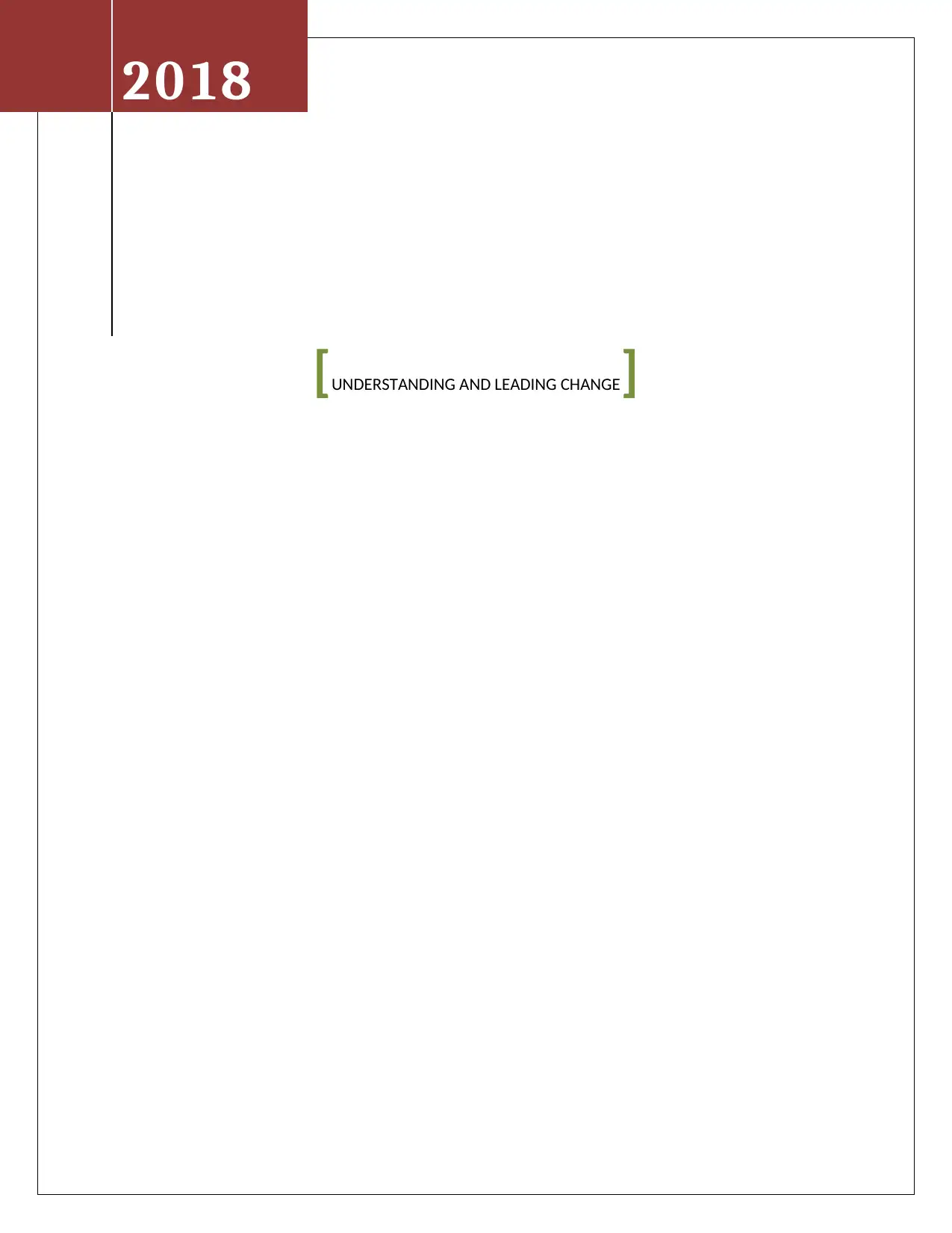
[UNDERSTANDING AND LEADING CHANGE]
2018
2018
Secure Best Marks with AI Grader
Need help grading? Try our AI Grader for instant feedback on your assignments.
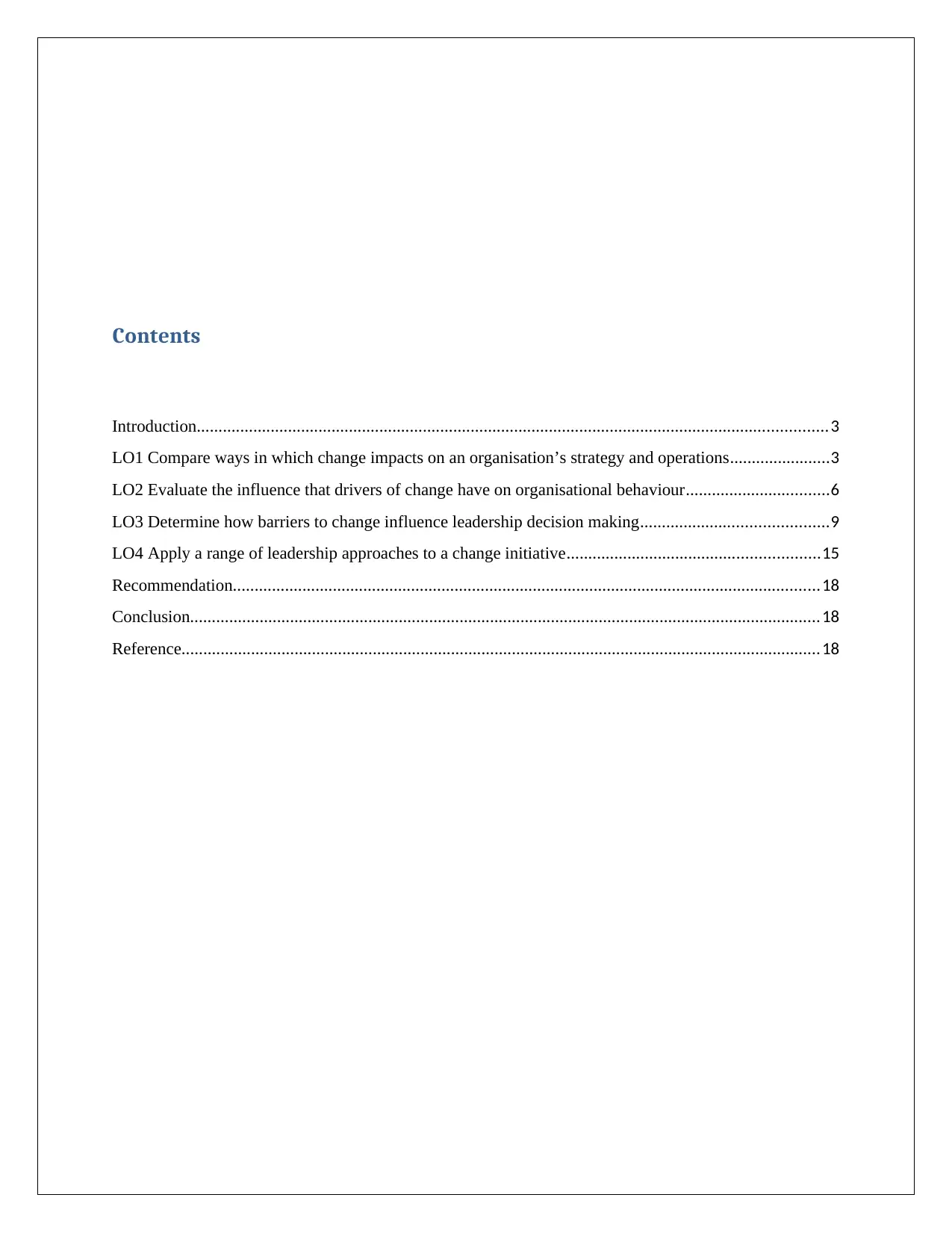
Contents
Introduction.................................................................................................................................................3
LO1 Compare ways in which change impacts on an organisation’s strategy and operations.......................3
LO2 Evaluate the influence that drivers of change have on organisational behaviour.................................6
LO3 Determine how barriers to change influence leadership decision making...........................................9
LO4 Apply a range of leadership approaches to a change initiative..........................................................15
Recommendation.......................................................................................................................................18
Conclusion.................................................................................................................................................18
Reference...................................................................................................................................................18
Introduction.................................................................................................................................................3
LO1 Compare ways in which change impacts on an organisation’s strategy and operations.......................3
LO2 Evaluate the influence that drivers of change have on organisational behaviour.................................6
LO3 Determine how barriers to change influence leadership decision making...........................................9
LO4 Apply a range of leadership approaches to a change initiative..........................................................15
Recommendation.......................................................................................................................................18
Conclusion.................................................................................................................................................18
Reference...................................................................................................................................................18
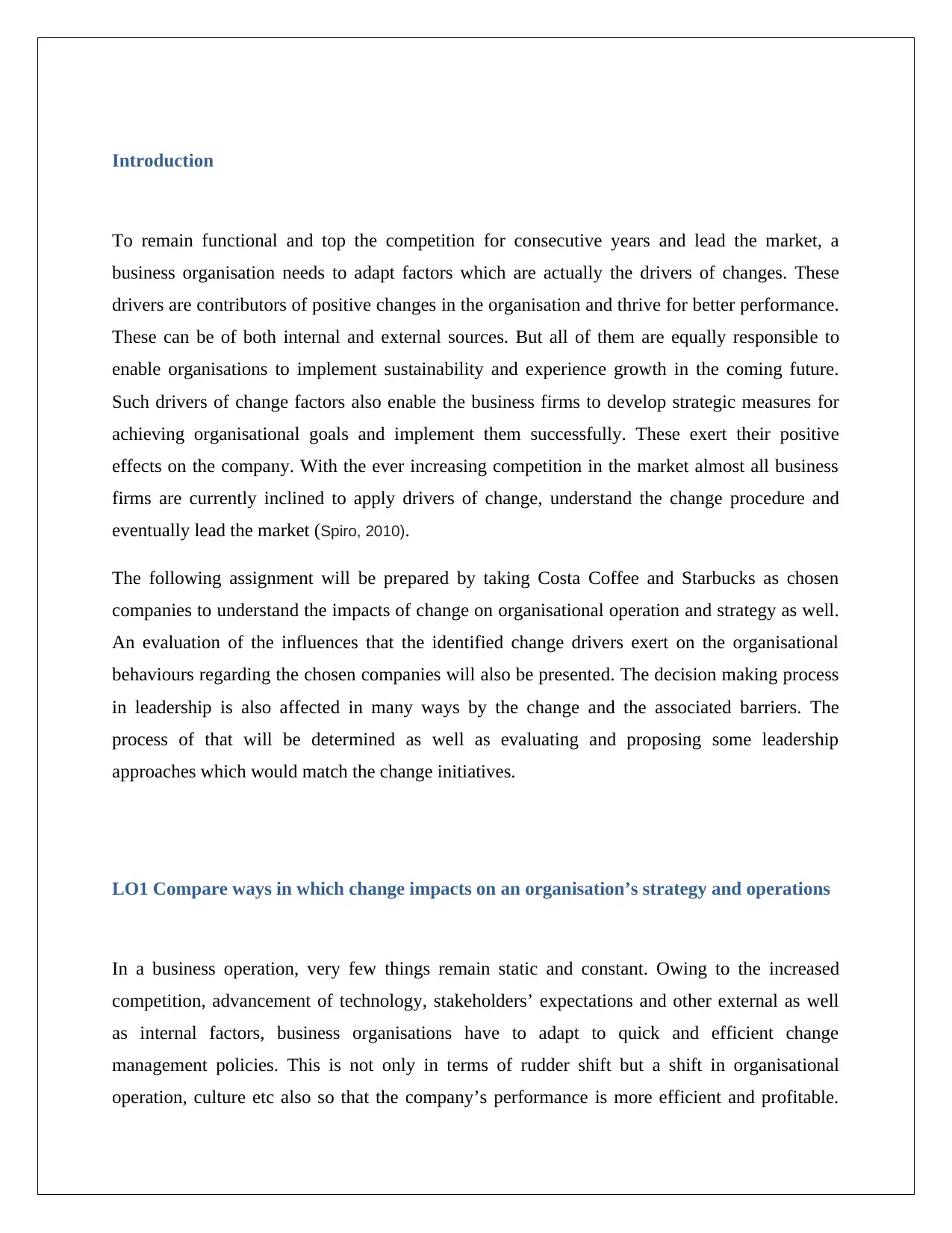
Introduction
To remain functional and top the competition for consecutive years and lead the market, a
business organisation needs to adapt factors which are actually the drivers of changes. These
drivers are contributors of positive changes in the organisation and thrive for better performance.
These can be of both internal and external sources. But all of them are equally responsible to
enable organisations to implement sustainability and experience growth in the coming future.
Such drivers of change factors also enable the business firms to develop strategic measures for
achieving organisational goals and implement them successfully. These exert their positive
effects on the company. With the ever increasing competition in the market almost all business
firms are currently inclined to apply drivers of change, understand the change procedure and
eventually lead the market (Spiro, 2010).
The following assignment will be prepared by taking Costa Coffee and Starbucks as chosen
companies to understand the impacts of change on organisational operation and strategy as well.
An evaluation of the influences that the identified change drivers exert on the organisational
behaviours regarding the chosen companies will also be presented. The decision making process
in leadership is also affected in many ways by the change and the associated barriers. The
process of that will be determined as well as evaluating and proposing some leadership
approaches which would match the change initiatives.
LO1 Compare ways in which change impacts on an organisation’s strategy and operations
In a business operation, very few things remain static and constant. Owing to the increased
competition, advancement of technology, stakeholders’ expectations and other external as well
as internal factors, business organisations have to adapt to quick and efficient change
management policies. This is not only in terms of rudder shift but a shift in organisational
operation, culture etc also so that the company’s performance is more efficient and profitable.
To remain functional and top the competition for consecutive years and lead the market, a
business organisation needs to adapt factors which are actually the drivers of changes. These
drivers are contributors of positive changes in the organisation and thrive for better performance.
These can be of both internal and external sources. But all of them are equally responsible to
enable organisations to implement sustainability and experience growth in the coming future.
Such drivers of change factors also enable the business firms to develop strategic measures for
achieving organisational goals and implement them successfully. These exert their positive
effects on the company. With the ever increasing competition in the market almost all business
firms are currently inclined to apply drivers of change, understand the change procedure and
eventually lead the market (Spiro, 2010).
The following assignment will be prepared by taking Costa Coffee and Starbucks as chosen
companies to understand the impacts of change on organisational operation and strategy as well.
An evaluation of the influences that the identified change drivers exert on the organisational
behaviours regarding the chosen companies will also be presented. The decision making process
in leadership is also affected in many ways by the change and the associated barriers. The
process of that will be determined as well as evaluating and proposing some leadership
approaches which would match the change initiatives.
LO1 Compare ways in which change impacts on an organisation’s strategy and operations
In a business operation, very few things remain static and constant. Owing to the increased
competition, advancement of technology, stakeholders’ expectations and other external as well
as internal factors, business organisations have to adapt to quick and efficient change
management policies. This is not only in terms of rudder shift but a shift in organisational
operation, culture etc also so that the company’s performance is more efficient and profitable.
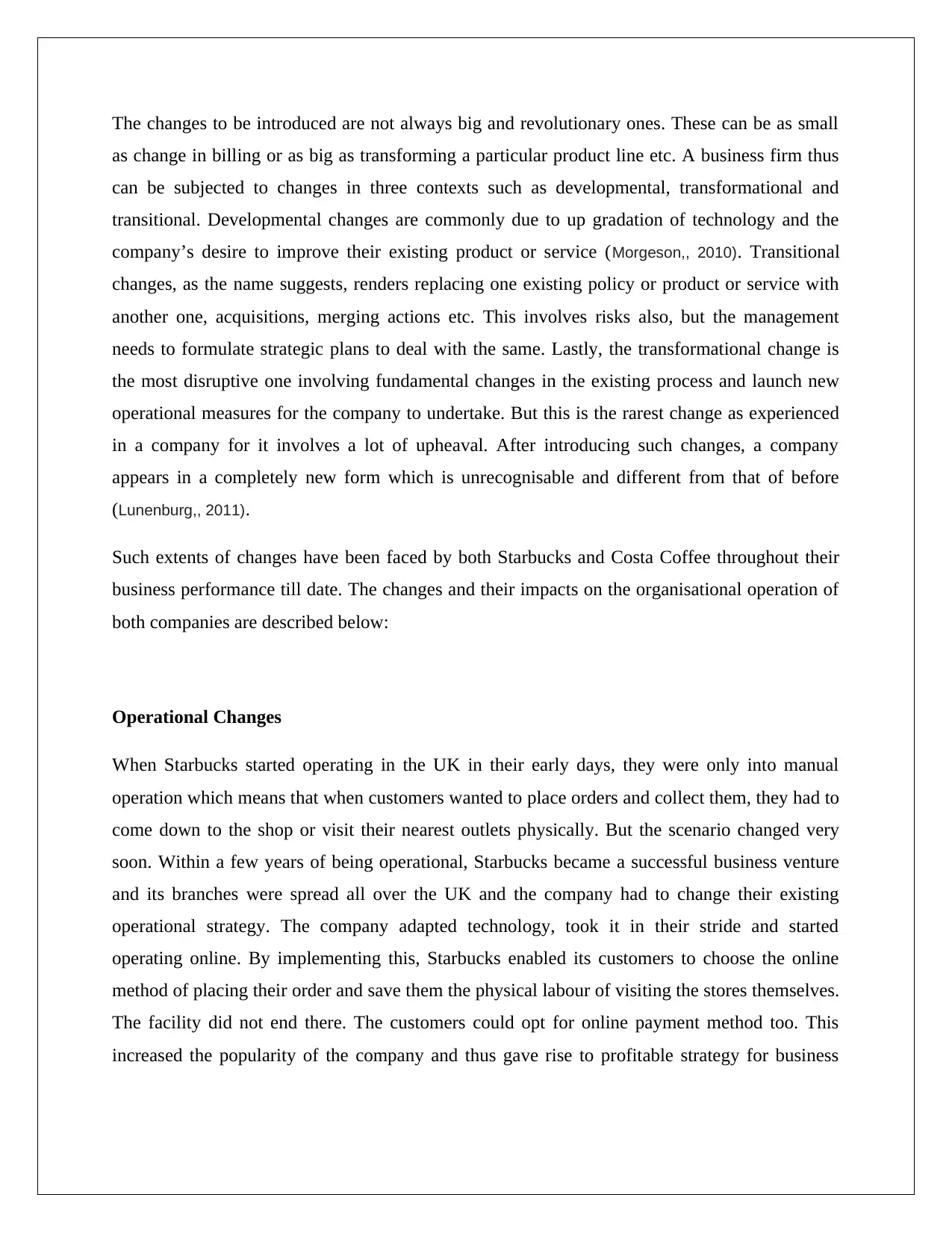
The changes to be introduced are not always big and revolutionary ones. These can be as small
as change in billing or as big as transforming a particular product line etc. A business firm thus
can be subjected to changes in three contexts such as developmental, transformational and
transitional. Developmental changes are commonly due to up gradation of technology and the
company’s desire to improve their existing product or service (Morgeson,, 2010). Transitional
changes, as the name suggests, renders replacing one existing policy or product or service with
another one, acquisitions, merging actions etc. This involves risks also, but the management
needs to formulate strategic plans to deal with the same. Lastly, the transformational change is
the most disruptive one involving fundamental changes in the existing process and launch new
operational measures for the company to undertake. But this is the rarest change as experienced
in a company for it involves a lot of upheaval. After introducing such changes, a company
appears in a completely new form which is unrecognisable and different from that of before
(Lunenburg,, 2011).
Such extents of changes have been faced by both Starbucks and Costa Coffee throughout their
business performance till date. The changes and their impacts on the organisational operation of
both companies are described below:
Operational Changes
When Starbucks started operating in the UK in their early days, they were only into manual
operation which means that when customers wanted to place orders and collect them, they had to
come down to the shop or visit their nearest outlets physically. But the scenario changed very
soon. Within a few years of being operational, Starbucks became a successful business venture
and its branches were spread all over the UK and the company had to change their existing
operational strategy. The company adapted technology, took it in their stride and started
operating online. By implementing this, Starbucks enabled its customers to choose the online
method of placing their order and save them the physical labour of visiting the stores themselves.
The facility did not end there. The customers could opt for online payment method too. This
increased the popularity of the company and thus gave rise to profitable strategy for business
as change in billing or as big as transforming a particular product line etc. A business firm thus
can be subjected to changes in three contexts such as developmental, transformational and
transitional. Developmental changes are commonly due to up gradation of technology and the
company’s desire to improve their existing product or service (Morgeson,, 2010). Transitional
changes, as the name suggests, renders replacing one existing policy or product or service with
another one, acquisitions, merging actions etc. This involves risks also, but the management
needs to formulate strategic plans to deal with the same. Lastly, the transformational change is
the most disruptive one involving fundamental changes in the existing process and launch new
operational measures for the company to undertake. But this is the rarest change as experienced
in a company for it involves a lot of upheaval. After introducing such changes, a company
appears in a completely new form which is unrecognisable and different from that of before
(Lunenburg,, 2011).
Such extents of changes have been faced by both Starbucks and Costa Coffee throughout their
business performance till date. The changes and their impacts on the organisational operation of
both companies are described below:
Operational Changes
When Starbucks started operating in the UK in their early days, they were only into manual
operation which means that when customers wanted to place orders and collect them, they had to
come down to the shop or visit their nearest outlets physically. But the scenario changed very
soon. Within a few years of being operational, Starbucks became a successful business venture
and its branches were spread all over the UK and the company had to change their existing
operational strategy. The company adapted technology, took it in their stride and started
operating online. By implementing this, Starbucks enabled its customers to choose the online
method of placing their order and save them the physical labour of visiting the stores themselves.
The facility did not end there. The customers could opt for online payment method too. This
increased the popularity of the company and thus gave rise to profitable strategy for business
Secure Best Marks with AI Grader
Need help grading? Try our AI Grader for instant feedback on your assignments.
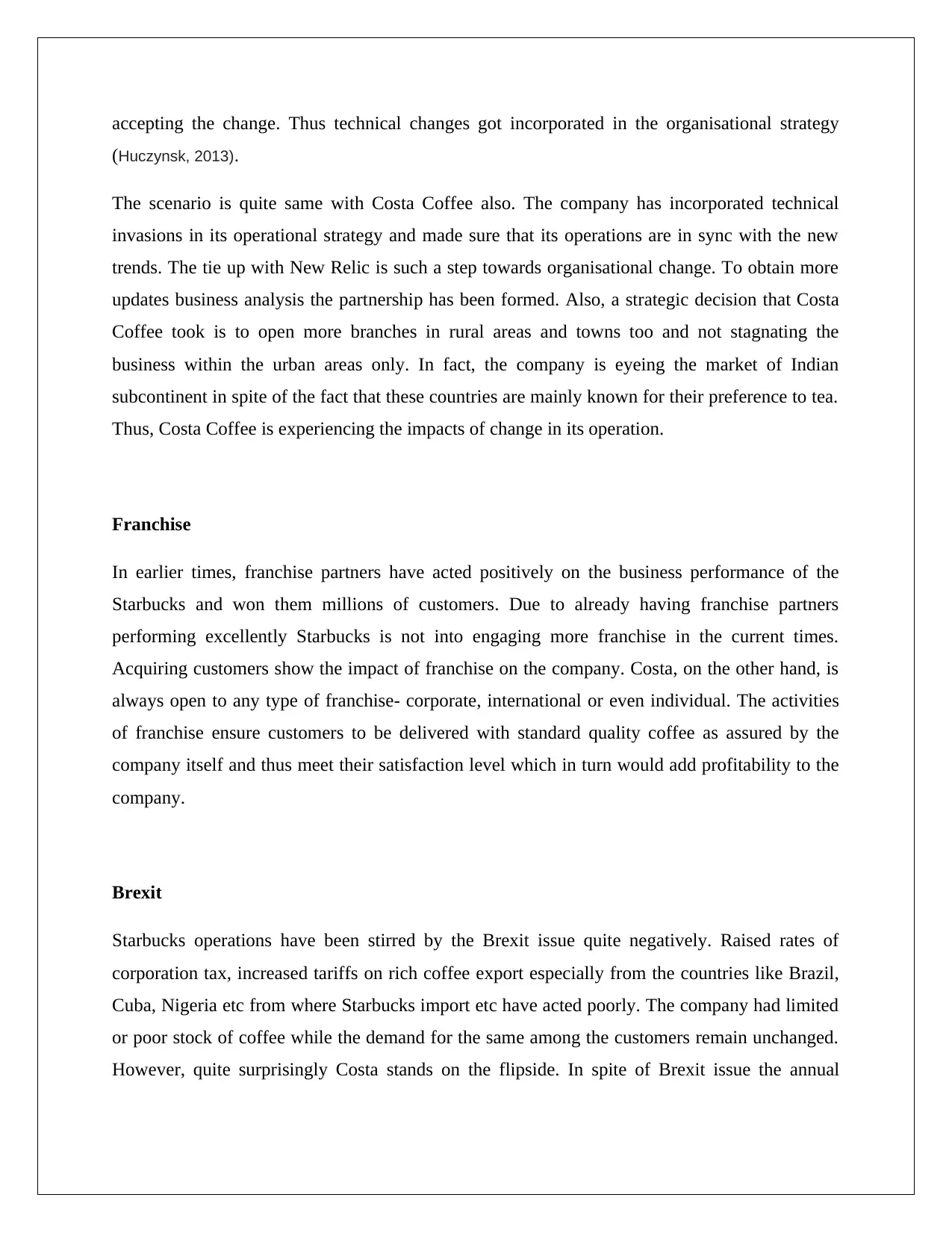
accepting the change. Thus technical changes got incorporated in the organisational strategy
(Huczynsk, 2013).
The scenario is quite same with Costa Coffee also. The company has incorporated technical
invasions in its operational strategy and made sure that its operations are in sync with the new
trends. The tie up with New Relic is such a step towards organisational change. To obtain more
updates business analysis the partnership has been formed. Also, a strategic decision that Costa
Coffee took is to open more branches in rural areas and towns too and not stagnating the
business within the urban areas only. In fact, the company is eyeing the market of Indian
subcontinent in spite of the fact that these countries are mainly known for their preference to tea.
Thus, Costa Coffee is experiencing the impacts of change in its operation.
Franchise
In earlier times, franchise partners have acted positively on the business performance of the
Starbucks and won them millions of customers. Due to already having franchise partners
performing excellently Starbucks is not into engaging more franchise in the current times.
Acquiring customers show the impact of franchise on the company. Costa, on the other hand, is
always open to any type of franchise- corporate, international or even individual. The activities
of franchise ensure customers to be delivered with standard quality coffee as assured by the
company itself and thus meet their satisfaction level which in turn would add profitability to the
company.
Brexit
Starbucks operations have been stirred by the Brexit issue quite negatively. Raised rates of
corporation tax, increased tariffs on rich coffee export especially from the countries like Brazil,
Cuba, Nigeria etc from where Starbucks import etc have acted poorly. The company had limited
or poor stock of coffee while the demand for the same among the customers remain unchanged.
However, quite surprisingly Costa stands on the flipside. In spite of Brexit issue the annual
(Huczynsk, 2013).
The scenario is quite same with Costa Coffee also. The company has incorporated technical
invasions in its operational strategy and made sure that its operations are in sync with the new
trends. The tie up with New Relic is such a step towards organisational change. To obtain more
updates business analysis the partnership has been formed. Also, a strategic decision that Costa
Coffee took is to open more branches in rural areas and towns too and not stagnating the
business within the urban areas only. In fact, the company is eyeing the market of Indian
subcontinent in spite of the fact that these countries are mainly known for their preference to tea.
Thus, Costa Coffee is experiencing the impacts of change in its operation.
Franchise
In earlier times, franchise partners have acted positively on the business performance of the
Starbucks and won them millions of customers. Due to already having franchise partners
performing excellently Starbucks is not into engaging more franchise in the current times.
Acquiring customers show the impact of franchise on the company. Costa, on the other hand, is
always open to any type of franchise- corporate, international or even individual. The activities
of franchise ensure customers to be delivered with standard quality coffee as assured by the
company itself and thus meet their satisfaction level which in turn would add profitability to the
company.
Brexit
Starbucks operations have been stirred by the Brexit issue quite negatively. Raised rates of
corporation tax, increased tariffs on rich coffee export especially from the countries like Brazil,
Cuba, Nigeria etc from where Starbucks import etc have acted poorly. The company had limited
or poor stock of coffee while the demand for the same among the customers remain unchanged.
However, quite surprisingly Costa stands on the flipside. In spite of Brexit issue the annual
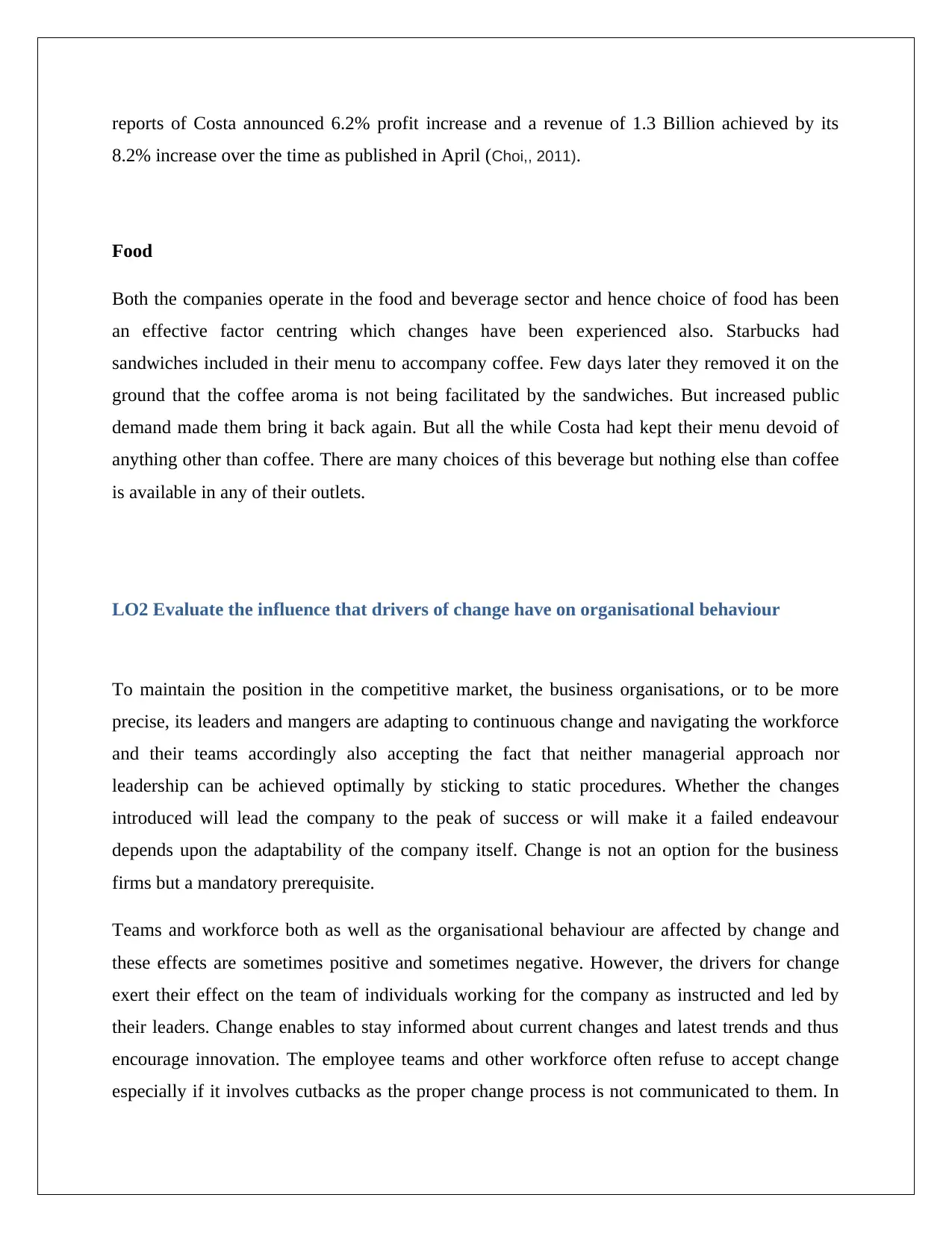
reports of Costa announced 6.2% profit increase and a revenue of 1.3 Billion achieved by its
8.2% increase over the time as published in April (Choi,, 2011).
Food
Both the companies operate in the food and beverage sector and hence choice of food has been
an effective factor centring which changes have been experienced also. Starbucks had
sandwiches included in their menu to accompany coffee. Few days later they removed it on the
ground that the coffee aroma is not being facilitated by the sandwiches. But increased public
demand made them bring it back again. But all the while Costa had kept their menu devoid of
anything other than coffee. There are many choices of this beverage but nothing else than coffee
is available in any of their outlets.
LO2 Evaluate the influence that drivers of change have on organisational behaviour
To maintain the position in the competitive market, the business organisations, or to be more
precise, its leaders and mangers are adapting to continuous change and navigating the workforce
and their teams accordingly also accepting the fact that neither managerial approach nor
leadership can be achieved optimally by sticking to static procedures. Whether the changes
introduced will lead the company to the peak of success or will make it a failed endeavour
depends upon the adaptability of the company itself. Change is not an option for the business
firms but a mandatory prerequisite.
Teams and workforce both as well as the organisational behaviour are affected by change and
these effects are sometimes positive and sometimes negative. However, the drivers for change
exert their effect on the team of individuals working for the company as instructed and led by
their leaders. Change enables to stay informed about current changes and latest trends and thus
encourage innovation. The employee teams and other workforce often refuse to accept change
especially if it involves cutbacks as the proper change process is not communicated to them. In
8.2% increase over the time as published in April (Choi,, 2011).
Food
Both the companies operate in the food and beverage sector and hence choice of food has been
an effective factor centring which changes have been experienced also. Starbucks had
sandwiches included in their menu to accompany coffee. Few days later they removed it on the
ground that the coffee aroma is not being facilitated by the sandwiches. But increased public
demand made them bring it back again. But all the while Costa had kept their menu devoid of
anything other than coffee. There are many choices of this beverage but nothing else than coffee
is available in any of their outlets.
LO2 Evaluate the influence that drivers of change have on organisational behaviour
To maintain the position in the competitive market, the business organisations, or to be more
precise, its leaders and mangers are adapting to continuous change and navigating the workforce
and their teams accordingly also accepting the fact that neither managerial approach nor
leadership can be achieved optimally by sticking to static procedures. Whether the changes
introduced will lead the company to the peak of success or will make it a failed endeavour
depends upon the adaptability of the company itself. Change is not an option for the business
firms but a mandatory prerequisite.
Teams and workforce both as well as the organisational behaviour are affected by change and
these effects are sometimes positive and sometimes negative. However, the drivers for change
exert their effect on the team of individuals working for the company as instructed and led by
their leaders. Change enables to stay informed about current changes and latest trends and thus
encourage innovation. The employee teams and other workforce often refuse to accept change
especially if it involves cutbacks as the proper change process is not communicated to them. In
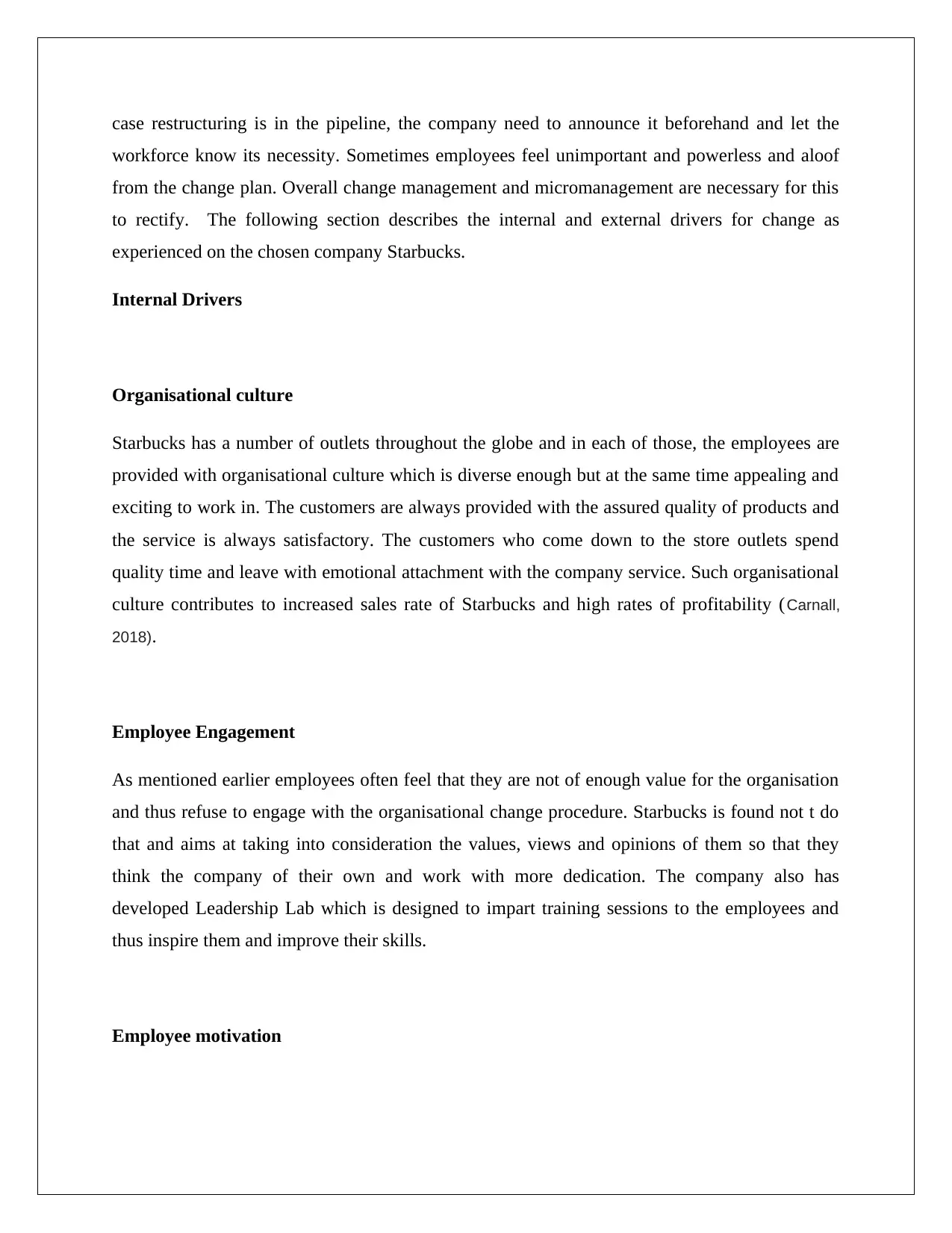
case restructuring is in the pipeline, the company need to announce it beforehand and let the
workforce know its necessity. Sometimes employees feel unimportant and powerless and aloof
from the change plan. Overall change management and micromanagement are necessary for this
to rectify. The following section describes the internal and external drivers for change as
experienced on the chosen company Starbucks.
Internal Drivers
Organisational culture
Starbucks has a number of outlets throughout the globe and in each of those, the employees are
provided with organisational culture which is diverse enough but at the same time appealing and
exciting to work in. The customers are always provided with the assured quality of products and
the service is always satisfactory. The customers who come down to the store outlets spend
quality time and leave with emotional attachment with the company service. Such organisational
culture contributes to increased sales rate of Starbucks and high rates of profitability (Carnall,
2018).
Employee Engagement
As mentioned earlier employees often feel that they are not of enough value for the organisation
and thus refuse to engage with the organisational change procedure. Starbucks is found not t do
that and aims at taking into consideration the values, views and opinions of them so that they
think the company of their own and work with more dedication. The company also has
developed Leadership Lab which is designed to impart training sessions to the employees and
thus inspire them and improve their skills.
Employee motivation
workforce know its necessity. Sometimes employees feel unimportant and powerless and aloof
from the change plan. Overall change management and micromanagement are necessary for this
to rectify. The following section describes the internal and external drivers for change as
experienced on the chosen company Starbucks.
Internal Drivers
Organisational culture
Starbucks has a number of outlets throughout the globe and in each of those, the employees are
provided with organisational culture which is diverse enough but at the same time appealing and
exciting to work in. The customers are always provided with the assured quality of products and
the service is always satisfactory. The customers who come down to the store outlets spend
quality time and leave with emotional attachment with the company service. Such organisational
culture contributes to increased sales rate of Starbucks and high rates of profitability (Carnall,
2018).
Employee Engagement
As mentioned earlier employees often feel that they are not of enough value for the organisation
and thus refuse to engage with the organisational change procedure. Starbucks is found not t do
that and aims at taking into consideration the values, views and opinions of them so that they
think the company of their own and work with more dedication. The company also has
developed Leadership Lab which is designed to impart training sessions to the employees and
thus inspire them and improve their skills.
Employee motivation
Paraphrase This Document
Need a fresh take? Get an instant paraphrase of this document with our AI Paraphraser
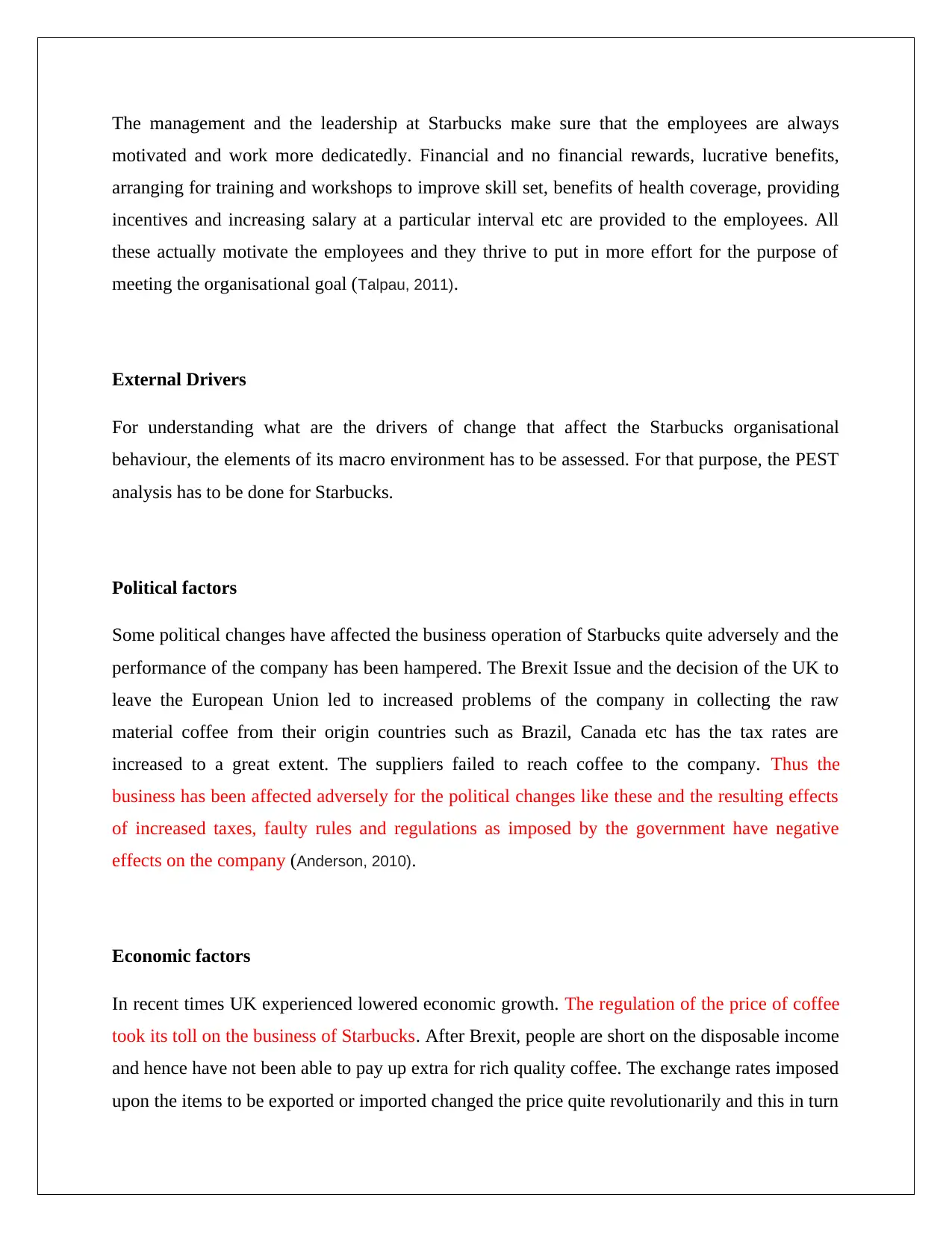
The management and the leadership at Starbucks make sure that the employees are always
motivated and work more dedicatedly. Financial and no financial rewards, lucrative benefits,
arranging for training and workshops to improve skill set, benefits of health coverage, providing
incentives and increasing salary at a particular interval etc are provided to the employees. All
these actually motivate the employees and they thrive to put in more effort for the purpose of
meeting the organisational goal (Talpau, 2011).
External Drivers
For understanding what are the drivers of change that affect the Starbucks organisational
behaviour, the elements of its macro environment has to be assessed. For that purpose, the PEST
analysis has to be done for Starbucks.
Political factors
Some political changes have affected the business operation of Starbucks quite adversely and the
performance of the company has been hampered. The Brexit Issue and the decision of the UK to
leave the European Union led to increased problems of the company in collecting the raw
material coffee from their origin countries such as Brazil, Canada etc has the tax rates are
increased to a great extent. The suppliers failed to reach coffee to the company. Thus the
business has been affected adversely for the political changes like these and the resulting effects
of increased taxes, faulty rules and regulations as imposed by the government have negative
effects on the company (Anderson, 2010).
Economic factors
In recent times UK experienced lowered economic growth. The regulation of the price of coffee
took its toll on the business of Starbucks. After Brexit, people are short on the disposable income
and hence have not been able to pay up extra for rich quality coffee. The exchange rates imposed
upon the items to be exported or imported changed the price quite revolutionarily and this in turn
motivated and work more dedicatedly. Financial and no financial rewards, lucrative benefits,
arranging for training and workshops to improve skill set, benefits of health coverage, providing
incentives and increasing salary at a particular interval etc are provided to the employees. All
these actually motivate the employees and they thrive to put in more effort for the purpose of
meeting the organisational goal (Talpau, 2011).
External Drivers
For understanding what are the drivers of change that affect the Starbucks organisational
behaviour, the elements of its macro environment has to be assessed. For that purpose, the PEST
analysis has to be done for Starbucks.
Political factors
Some political changes have affected the business operation of Starbucks quite adversely and the
performance of the company has been hampered. The Brexit Issue and the decision of the UK to
leave the European Union led to increased problems of the company in collecting the raw
material coffee from their origin countries such as Brazil, Canada etc has the tax rates are
increased to a great extent. The suppliers failed to reach coffee to the company. Thus the
business has been affected adversely for the political changes like these and the resulting effects
of increased taxes, faulty rules and regulations as imposed by the government have negative
effects on the company (Anderson, 2010).
Economic factors
In recent times UK experienced lowered economic growth. The regulation of the price of coffee
took its toll on the business of Starbucks. After Brexit, people are short on the disposable income
and hence have not been able to pay up extra for rich quality coffee. The exchange rates imposed
upon the items to be exported or imported changed the price quite revolutionarily and this in turn
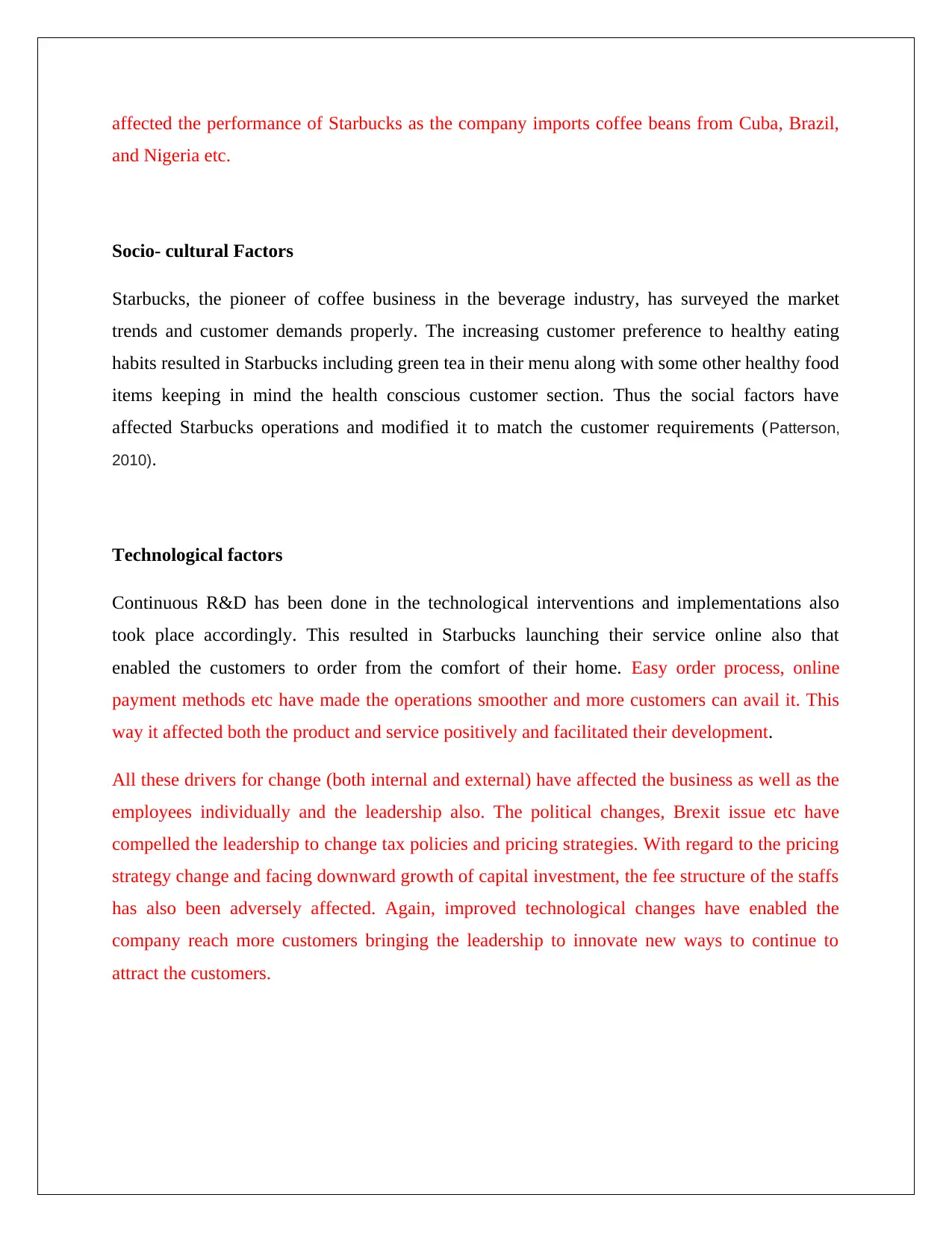
affected the performance of Starbucks as the company imports coffee beans from Cuba, Brazil,
and Nigeria etc.
Socio- cultural Factors
Starbucks, the pioneer of coffee business in the beverage industry, has surveyed the market
trends and customer demands properly. The increasing customer preference to healthy eating
habits resulted in Starbucks including green tea in their menu along with some other healthy food
items keeping in mind the health conscious customer section. Thus the social factors have
affected Starbucks operations and modified it to match the customer requirements (Patterson,
2010).
Technological factors
Continuous R&D has been done in the technological interventions and implementations also
took place accordingly. This resulted in Starbucks launching their service online also that
enabled the customers to order from the comfort of their home. Easy order process, online
payment methods etc have made the operations smoother and more customers can avail it. This
way it affected both the product and service positively and facilitated their development.
All these drivers for change (both internal and external) have affected the business as well as the
employees individually and the leadership also. The political changes, Brexit issue etc have
compelled the leadership to change tax policies and pricing strategies. With regard to the pricing
strategy change and facing downward growth of capital investment, the fee structure of the staffs
has also been adversely affected. Again, improved technological changes have enabled the
company reach more customers bringing the leadership to innovate new ways to continue to
attract the customers.
and Nigeria etc.
Socio- cultural Factors
Starbucks, the pioneer of coffee business in the beverage industry, has surveyed the market
trends and customer demands properly. The increasing customer preference to healthy eating
habits resulted in Starbucks including green tea in their menu along with some other healthy food
items keeping in mind the health conscious customer section. Thus the social factors have
affected Starbucks operations and modified it to match the customer requirements (Patterson,
2010).
Technological factors
Continuous R&D has been done in the technological interventions and implementations also
took place accordingly. This resulted in Starbucks launching their service online also that
enabled the customers to order from the comfort of their home. Easy order process, online
payment methods etc have made the operations smoother and more customers can avail it. This
way it affected both the product and service positively and facilitated their development.
All these drivers for change (both internal and external) have affected the business as well as the
employees individually and the leadership also. The political changes, Brexit issue etc have
compelled the leadership to change tax policies and pricing strategies. With regard to the pricing
strategy change and facing downward growth of capital investment, the fee structure of the staffs
has also been adversely affected. Again, improved technological changes have enabled the
company reach more customers bringing the leadership to innovate new ways to continue to
attract the customers.
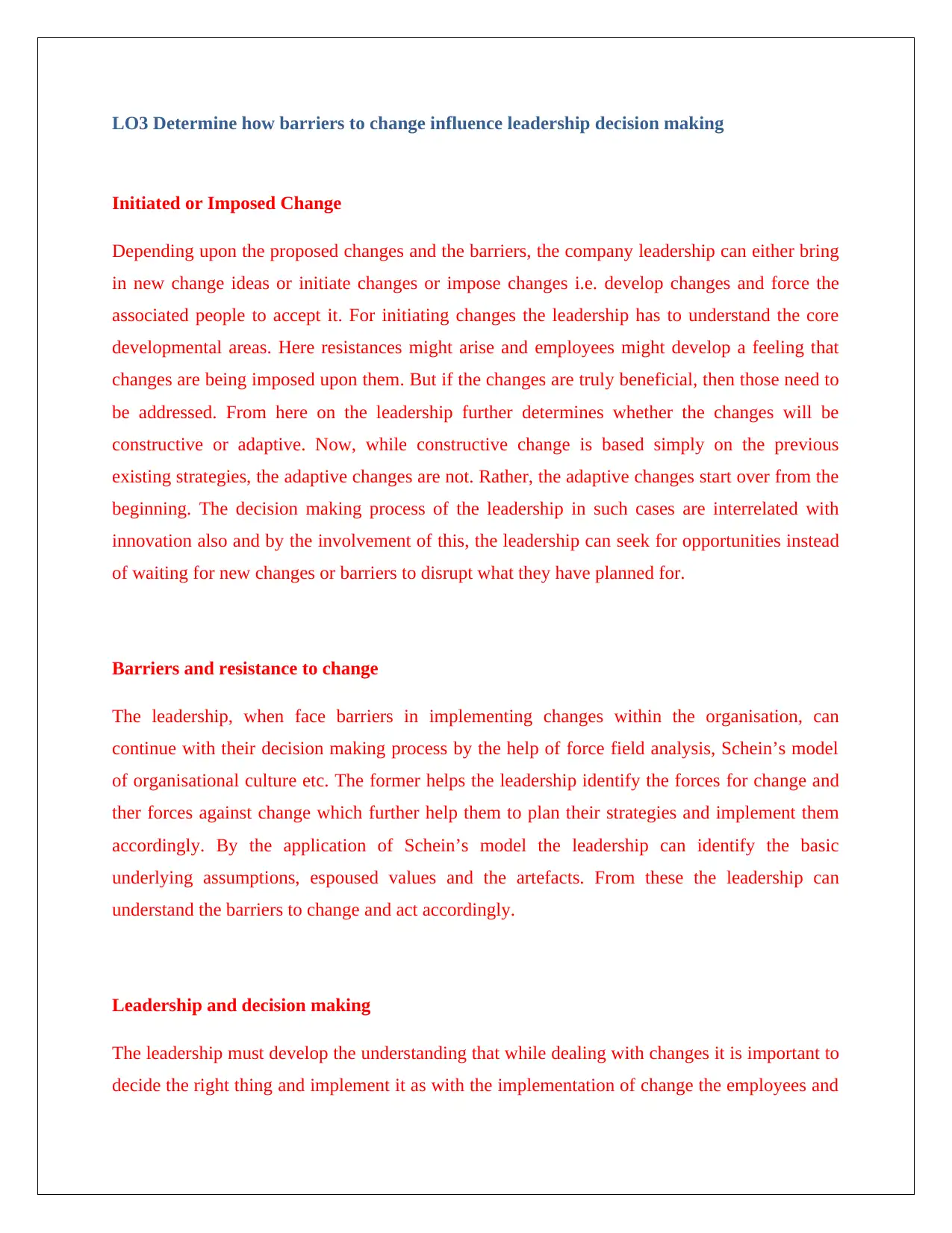
LO3 Determine how barriers to change influence leadership decision making
Initiated or Imposed Change
Depending upon the proposed changes and the barriers, the company leadership can either bring
in new change ideas or initiate changes or impose changes i.e. develop changes and force the
associated people to accept it. For initiating changes the leadership has to understand the core
developmental areas. Here resistances might arise and employees might develop a feeling that
changes are being imposed upon them. But if the changes are truly beneficial, then those need to
be addressed. From here on the leadership further determines whether the changes will be
constructive or adaptive. Now, while constructive change is based simply on the previous
existing strategies, the adaptive changes are not. Rather, the adaptive changes start over from the
beginning. The decision making process of the leadership in such cases are interrelated with
innovation also and by the involvement of this, the leadership can seek for opportunities instead
of waiting for new changes or barriers to disrupt what they have planned for.
Barriers and resistance to change
The leadership, when face barriers in implementing changes within the organisation, can
continue with their decision making process by the help of force field analysis, Schein’s model
of organisational culture etc. The former helps the leadership identify the forces for change and
ther forces against change which further help them to plan their strategies and implement them
accordingly. By the application of Schein’s model the leadership can identify the basic
underlying assumptions, espoused values and the artefacts. From these the leadership can
understand the barriers to change and act accordingly.
Leadership and decision making
The leadership must develop the understanding that while dealing with changes it is important to
decide the right thing and implement it as with the implementation of change the employees and
Initiated or Imposed Change
Depending upon the proposed changes and the barriers, the company leadership can either bring
in new change ideas or initiate changes or impose changes i.e. develop changes and force the
associated people to accept it. For initiating changes the leadership has to understand the core
developmental areas. Here resistances might arise and employees might develop a feeling that
changes are being imposed upon them. But if the changes are truly beneficial, then those need to
be addressed. From here on the leadership further determines whether the changes will be
constructive or adaptive. Now, while constructive change is based simply on the previous
existing strategies, the adaptive changes are not. Rather, the adaptive changes start over from the
beginning. The decision making process of the leadership in such cases are interrelated with
innovation also and by the involvement of this, the leadership can seek for opportunities instead
of waiting for new changes or barriers to disrupt what they have planned for.
Barriers and resistance to change
The leadership, when face barriers in implementing changes within the organisation, can
continue with their decision making process by the help of force field analysis, Schein’s model
of organisational culture etc. The former helps the leadership identify the forces for change and
ther forces against change which further help them to plan their strategies and implement them
accordingly. By the application of Schein’s model the leadership can identify the basic
underlying assumptions, espoused values and the artefacts. From these the leadership can
understand the barriers to change and act accordingly.
Leadership and decision making
The leadership must develop the understanding that while dealing with changes it is important to
decide the right thing and implement it as with the implementation of change the employees and
Secure Best Marks with AI Grader
Need help grading? Try our AI Grader for instant feedback on your assignments.
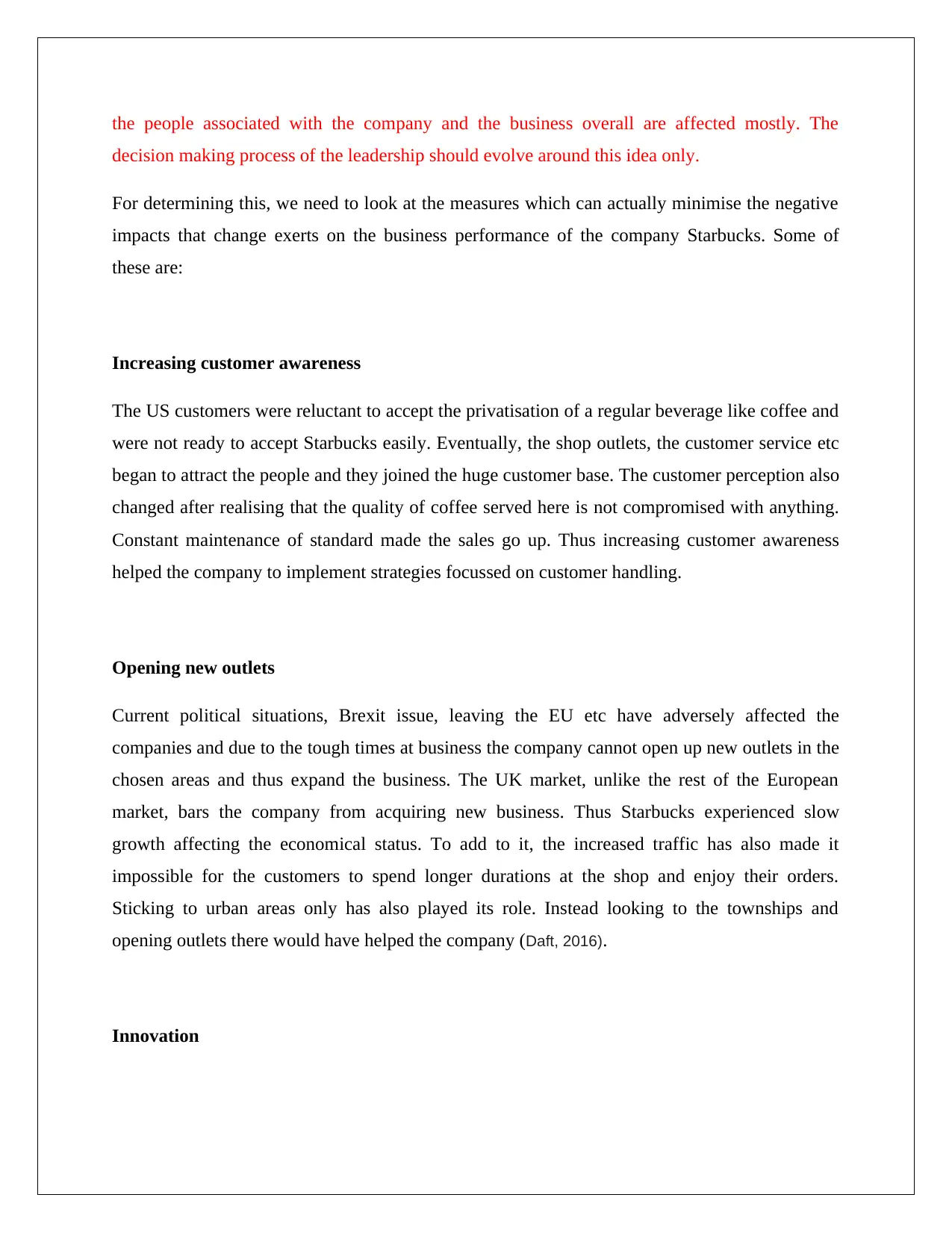
the people associated with the company and the business overall are affected mostly. The
decision making process of the leadership should evolve around this idea only.
For determining this, we need to look at the measures which can actually minimise the negative
impacts that change exerts on the business performance of the company Starbucks. Some of
these are:
Increasing customer awareness
The US customers were reluctant to accept the privatisation of a regular beverage like coffee and
were not ready to accept Starbucks easily. Eventually, the shop outlets, the customer service etc
began to attract the people and they joined the huge customer base. The customer perception also
changed after realising that the quality of coffee served here is not compromised with anything.
Constant maintenance of standard made the sales go up. Thus increasing customer awareness
helped the company to implement strategies focussed on customer handling.
Opening new outlets
Current political situations, Brexit issue, leaving the EU etc have adversely affected the
companies and due to the tough times at business the company cannot open up new outlets in the
chosen areas and thus expand the business. The UK market, unlike the rest of the European
market, bars the company from acquiring new business. Thus Starbucks experienced slow
growth affecting the economical status. To add to it, the increased traffic has also made it
impossible for the customers to spend longer durations at the shop and enjoy their orders.
Sticking to urban areas only has also played its role. Instead looking to the townships and
opening outlets there would have helped the company (Daft, 2016).
Innovation
decision making process of the leadership should evolve around this idea only.
For determining this, we need to look at the measures which can actually minimise the negative
impacts that change exerts on the business performance of the company Starbucks. Some of
these are:
Increasing customer awareness
The US customers were reluctant to accept the privatisation of a regular beverage like coffee and
were not ready to accept Starbucks easily. Eventually, the shop outlets, the customer service etc
began to attract the people and they joined the huge customer base. The customer perception also
changed after realising that the quality of coffee served here is not compromised with anything.
Constant maintenance of standard made the sales go up. Thus increasing customer awareness
helped the company to implement strategies focussed on customer handling.
Opening new outlets
Current political situations, Brexit issue, leaving the EU etc have adversely affected the
companies and due to the tough times at business the company cannot open up new outlets in the
chosen areas and thus expand the business. The UK market, unlike the rest of the European
market, bars the company from acquiring new business. Thus Starbucks experienced slow
growth affecting the economical status. To add to it, the increased traffic has also made it
impossible for the customers to spend longer durations at the shop and enjoy their orders.
Sticking to urban areas only has also played its role. Instead looking to the townships and
opening outlets there would have helped the company (Daft, 2016).
Innovation
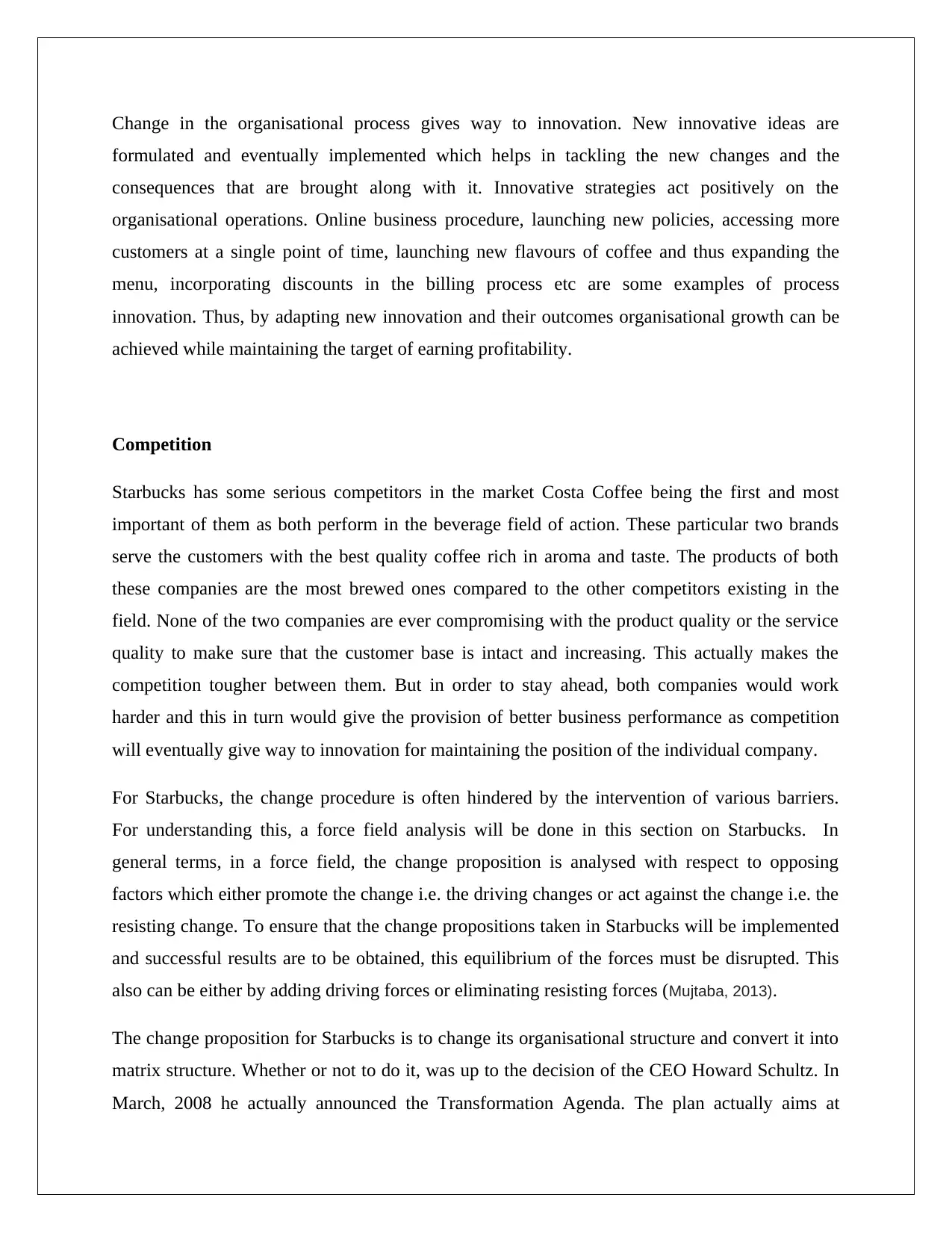
Change in the organisational process gives way to innovation. New innovative ideas are
formulated and eventually implemented which helps in tackling the new changes and the
consequences that are brought along with it. Innovative strategies act positively on the
organisational operations. Online business procedure, launching new policies, accessing more
customers at a single point of time, launching new flavours of coffee and thus expanding the
menu, incorporating discounts in the billing process etc are some examples of process
innovation. Thus, by adapting new innovation and their outcomes organisational growth can be
achieved while maintaining the target of earning profitability.
Competition
Starbucks has some serious competitors in the market Costa Coffee being the first and most
important of them as both perform in the beverage field of action. These particular two brands
serve the customers with the best quality coffee rich in aroma and taste. The products of both
these companies are the most brewed ones compared to the other competitors existing in the
field. None of the two companies are ever compromising with the product quality or the service
quality to make sure that the customer base is intact and increasing. This actually makes the
competition tougher between them. But in order to stay ahead, both companies would work
harder and this in turn would give the provision of better business performance as competition
will eventually give way to innovation for maintaining the position of the individual company.
For Starbucks, the change procedure is often hindered by the intervention of various barriers.
For understanding this, a force field analysis will be done in this section on Starbucks. In
general terms, in a force field, the change proposition is analysed with respect to opposing
factors which either promote the change i.e. the driving changes or act against the change i.e. the
resisting change. To ensure that the change propositions taken in Starbucks will be implemented
and successful results are to be obtained, this equilibrium of the forces must be disrupted. This
also can be either by adding driving forces or eliminating resisting forces (Mujtaba, 2013).
The change proposition for Starbucks is to change its organisational structure and convert it into
matrix structure. Whether or not to do it, was up to the decision of the CEO Howard Schultz. In
March, 2008 he actually announced the Transformation Agenda. The plan actually aims at
formulated and eventually implemented which helps in tackling the new changes and the
consequences that are brought along with it. Innovative strategies act positively on the
organisational operations. Online business procedure, launching new policies, accessing more
customers at a single point of time, launching new flavours of coffee and thus expanding the
menu, incorporating discounts in the billing process etc are some examples of process
innovation. Thus, by adapting new innovation and their outcomes organisational growth can be
achieved while maintaining the target of earning profitability.
Competition
Starbucks has some serious competitors in the market Costa Coffee being the first and most
important of them as both perform in the beverage field of action. These particular two brands
serve the customers with the best quality coffee rich in aroma and taste. The products of both
these companies are the most brewed ones compared to the other competitors existing in the
field. None of the two companies are ever compromising with the product quality or the service
quality to make sure that the customer base is intact and increasing. This actually makes the
competition tougher between them. But in order to stay ahead, both companies would work
harder and this in turn would give the provision of better business performance as competition
will eventually give way to innovation for maintaining the position of the individual company.
For Starbucks, the change procedure is often hindered by the intervention of various barriers.
For understanding this, a force field analysis will be done in this section on Starbucks. In
general terms, in a force field, the change proposition is analysed with respect to opposing
factors which either promote the change i.e. the driving changes or act against the change i.e. the
resisting change. To ensure that the change propositions taken in Starbucks will be implemented
and successful results are to be obtained, this equilibrium of the forces must be disrupted. This
also can be either by adding driving forces or eliminating resisting forces (Mujtaba, 2013).
The change proposition for Starbucks is to change its organisational structure and convert it into
matrix structure. Whether or not to do it, was up to the decision of the CEO Howard Schultz. In
March, 2008 he actually announced the Transformation Agenda. The plan actually aims at
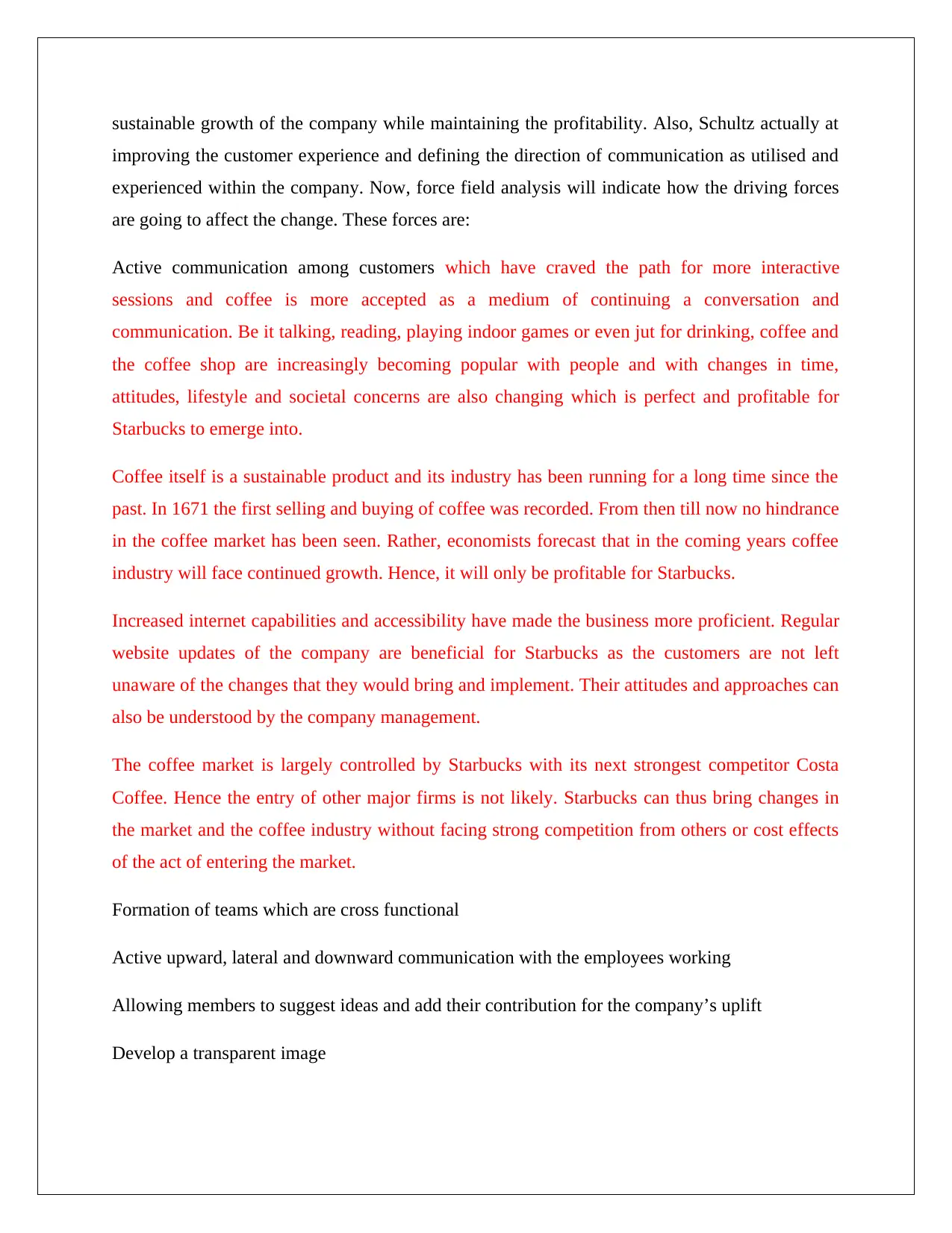
sustainable growth of the company while maintaining the profitability. Also, Schultz actually at
improving the customer experience and defining the direction of communication as utilised and
experienced within the company. Now, force field analysis will indicate how the driving forces
are going to affect the change. These forces are:
Active communication among customers which have craved the path for more interactive
sessions and coffee is more accepted as a medium of continuing a conversation and
communication. Be it talking, reading, playing indoor games or even jut for drinking, coffee and
the coffee shop are increasingly becoming popular with people and with changes in time,
attitudes, lifestyle and societal concerns are also changing which is perfect and profitable for
Starbucks to emerge into.
Coffee itself is a sustainable product and its industry has been running for a long time since the
past. In 1671 the first selling and buying of coffee was recorded. From then till now no hindrance
in the coffee market has been seen. Rather, economists forecast that in the coming years coffee
industry will face continued growth. Hence, it will only be profitable for Starbucks.
Increased internet capabilities and accessibility have made the business more proficient. Regular
website updates of the company are beneficial for Starbucks as the customers are not left
unaware of the changes that they would bring and implement. Their attitudes and approaches can
also be understood by the company management.
The coffee market is largely controlled by Starbucks with its next strongest competitor Costa
Coffee. Hence the entry of other major firms is not likely. Starbucks can thus bring changes in
the market and the coffee industry without facing strong competition from others or cost effects
of the act of entering the market.
Formation of teams which are cross functional
Active upward, lateral and downward communication with the employees working
Allowing members to suggest ideas and add their contribution for the company’s uplift
Develop a transparent image
improving the customer experience and defining the direction of communication as utilised and
experienced within the company. Now, force field analysis will indicate how the driving forces
are going to affect the change. These forces are:
Active communication among customers which have craved the path for more interactive
sessions and coffee is more accepted as a medium of continuing a conversation and
communication. Be it talking, reading, playing indoor games or even jut for drinking, coffee and
the coffee shop are increasingly becoming popular with people and with changes in time,
attitudes, lifestyle and societal concerns are also changing which is perfect and profitable for
Starbucks to emerge into.
Coffee itself is a sustainable product and its industry has been running for a long time since the
past. In 1671 the first selling and buying of coffee was recorded. From then till now no hindrance
in the coffee market has been seen. Rather, economists forecast that in the coming years coffee
industry will face continued growth. Hence, it will only be profitable for Starbucks.
Increased internet capabilities and accessibility have made the business more proficient. Regular
website updates of the company are beneficial for Starbucks as the customers are not left
unaware of the changes that they would bring and implement. Their attitudes and approaches can
also be understood by the company management.
The coffee market is largely controlled by Starbucks with its next strongest competitor Costa
Coffee. Hence the entry of other major firms is not likely. Starbucks can thus bring changes in
the market and the coffee industry without facing strong competition from others or cost effects
of the act of entering the market.
Formation of teams which are cross functional
Active upward, lateral and downward communication with the employees working
Allowing members to suggest ideas and add their contribution for the company’s uplift
Develop a transparent image
Paraphrase This Document
Need a fresh take? Get an instant paraphrase of this document with our AI Paraphraser
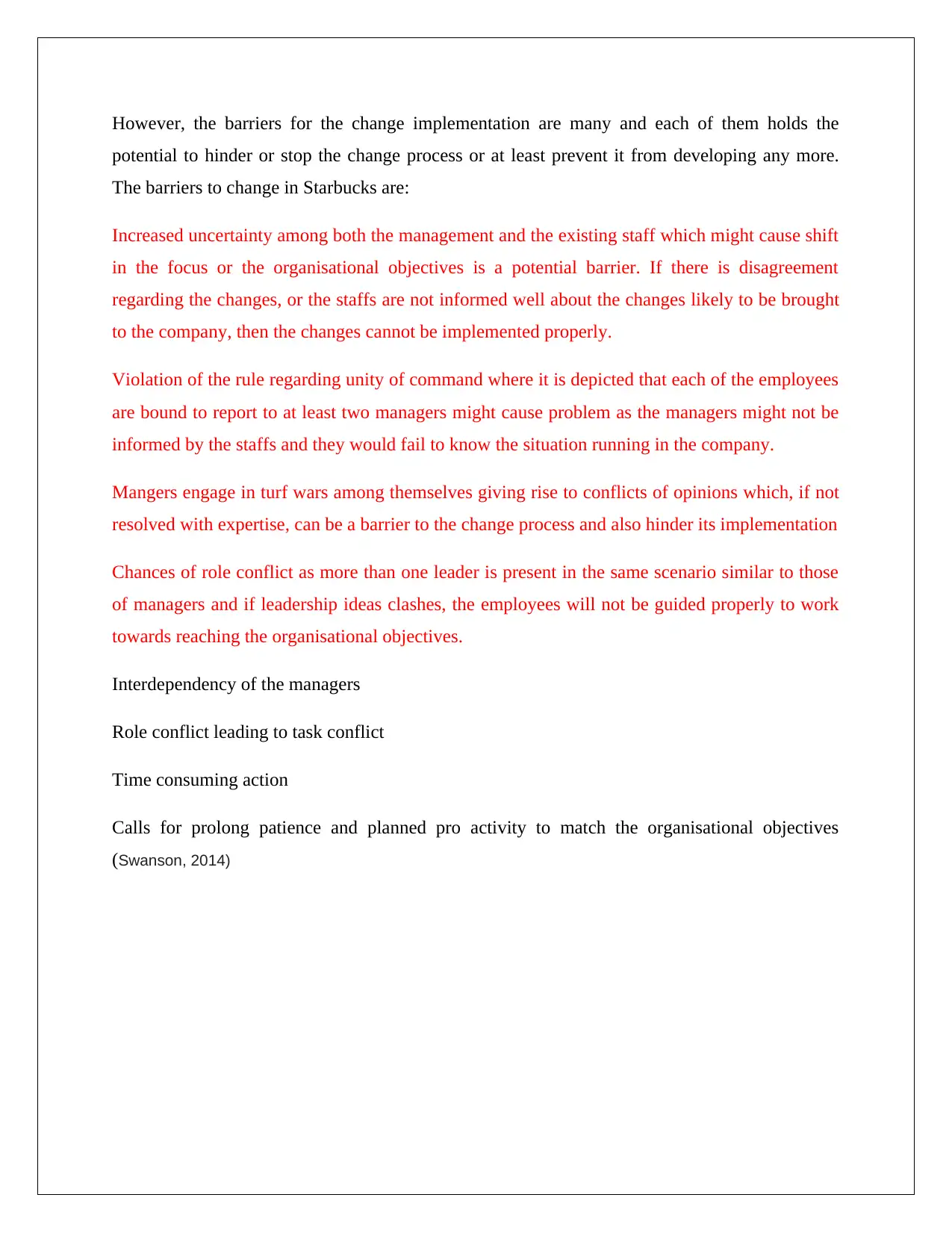
However, the barriers for the change implementation are many and each of them holds the
potential to hinder or stop the change process or at least prevent it from developing any more.
The barriers to change in Starbucks are:
Increased uncertainty among both the management and the existing staff which might cause shift
in the focus or the organisational objectives is a potential barrier. If there is disagreement
regarding the changes, or the staffs are not informed well about the changes likely to be brought
to the company, then the changes cannot be implemented properly.
Violation of the rule regarding unity of command where it is depicted that each of the employees
are bound to report to at least two managers might cause problem as the managers might not be
informed by the staffs and they would fail to know the situation running in the company.
Mangers engage in turf wars among themselves giving rise to conflicts of opinions which, if not
resolved with expertise, can be a barrier to the change process and also hinder its implementation
Chances of role conflict as more than one leader is present in the same scenario similar to those
of managers and if leadership ideas clashes, the employees will not be guided properly to work
towards reaching the organisational objectives.
Interdependency of the managers
Role conflict leading to task conflict
Time consuming action
Calls for prolong patience and planned pro activity to match the organisational objectives
(Swanson, 2014)
potential to hinder or stop the change process or at least prevent it from developing any more.
The barriers to change in Starbucks are:
Increased uncertainty among both the management and the existing staff which might cause shift
in the focus or the organisational objectives is a potential barrier. If there is disagreement
regarding the changes, or the staffs are not informed well about the changes likely to be brought
to the company, then the changes cannot be implemented properly.
Violation of the rule regarding unity of command where it is depicted that each of the employees
are bound to report to at least two managers might cause problem as the managers might not be
informed by the staffs and they would fail to know the situation running in the company.
Mangers engage in turf wars among themselves giving rise to conflicts of opinions which, if not
resolved with expertise, can be a barrier to the change process and also hinder its implementation
Chances of role conflict as more than one leader is present in the same scenario similar to those
of managers and if leadership ideas clashes, the employees will not be guided properly to work
towards reaching the organisational objectives.
Interdependency of the managers
Role conflict leading to task conflict
Time consuming action
Calls for prolong patience and planned pro activity to match the organisational objectives
(Swanson, 2014)
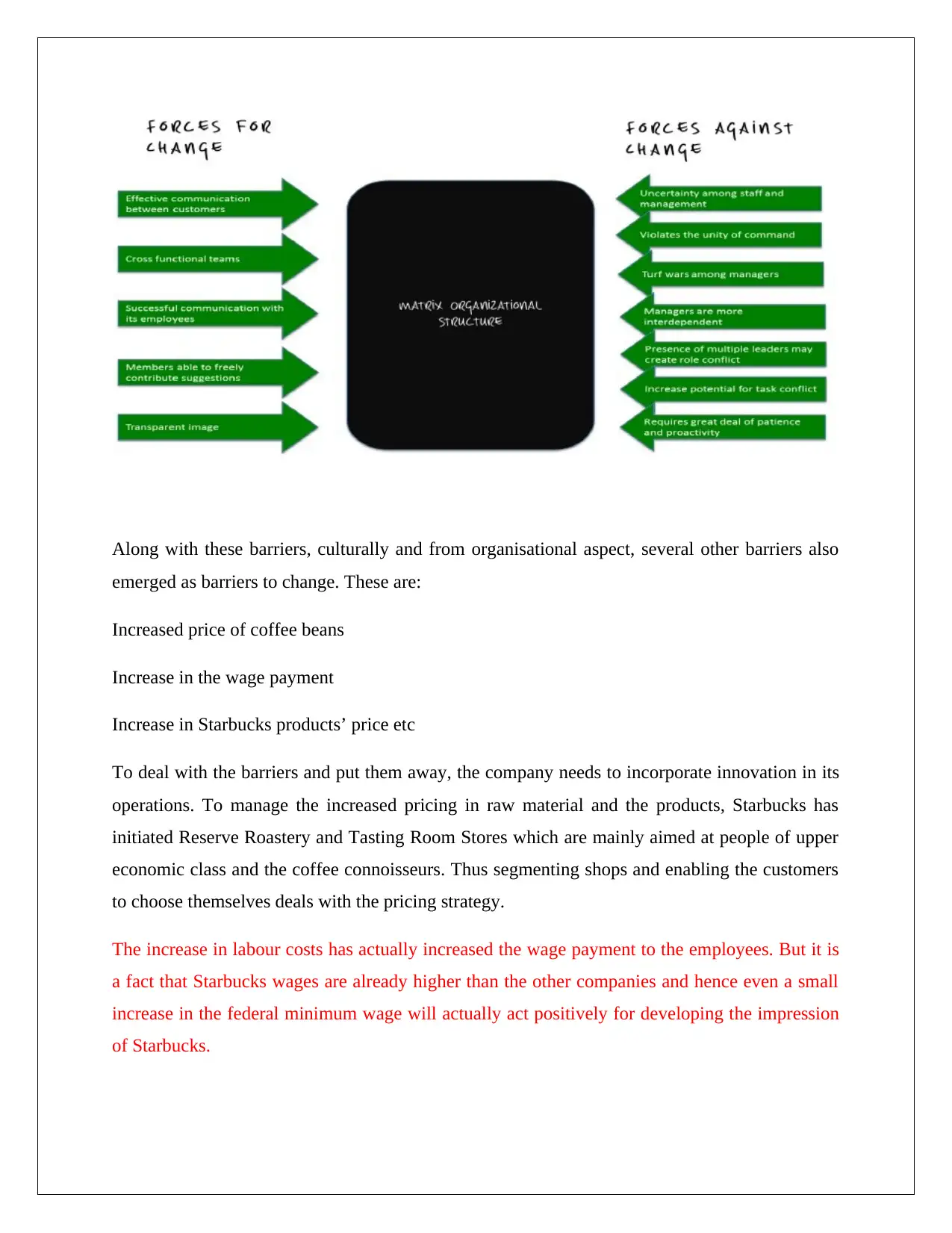
Along with these barriers, culturally and from organisational aspect, several other barriers also
emerged as barriers to change. These are:
Increased price of coffee beans
Increase in the wage payment
Increase in Starbucks products’ price etc
To deal with the barriers and put them away, the company needs to incorporate innovation in its
operations. To manage the increased pricing in raw material and the products, Starbucks has
initiated Reserve Roastery and Tasting Room Stores which are mainly aimed at people of upper
economic class and the coffee connoisseurs. Thus segmenting shops and enabling the customers
to choose themselves deals with the pricing strategy.
The increase in labour costs has actually increased the wage payment to the employees. But it is
a fact that Starbucks wages are already higher than the other companies and hence even a small
increase in the federal minimum wage will actually act positively for developing the impression
of Starbucks.
emerged as barriers to change. These are:
Increased price of coffee beans
Increase in the wage payment
Increase in Starbucks products’ price etc
To deal with the barriers and put them away, the company needs to incorporate innovation in its
operations. To manage the increased pricing in raw material and the products, Starbucks has
initiated Reserve Roastery and Tasting Room Stores which are mainly aimed at people of upper
economic class and the coffee connoisseurs. Thus segmenting shops and enabling the customers
to choose themselves deals with the pricing strategy.
The increase in labour costs has actually increased the wage payment to the employees. But it is
a fact that Starbucks wages are already higher than the other companies and hence even a small
increase in the federal minimum wage will actually act positively for developing the impression
of Starbucks.
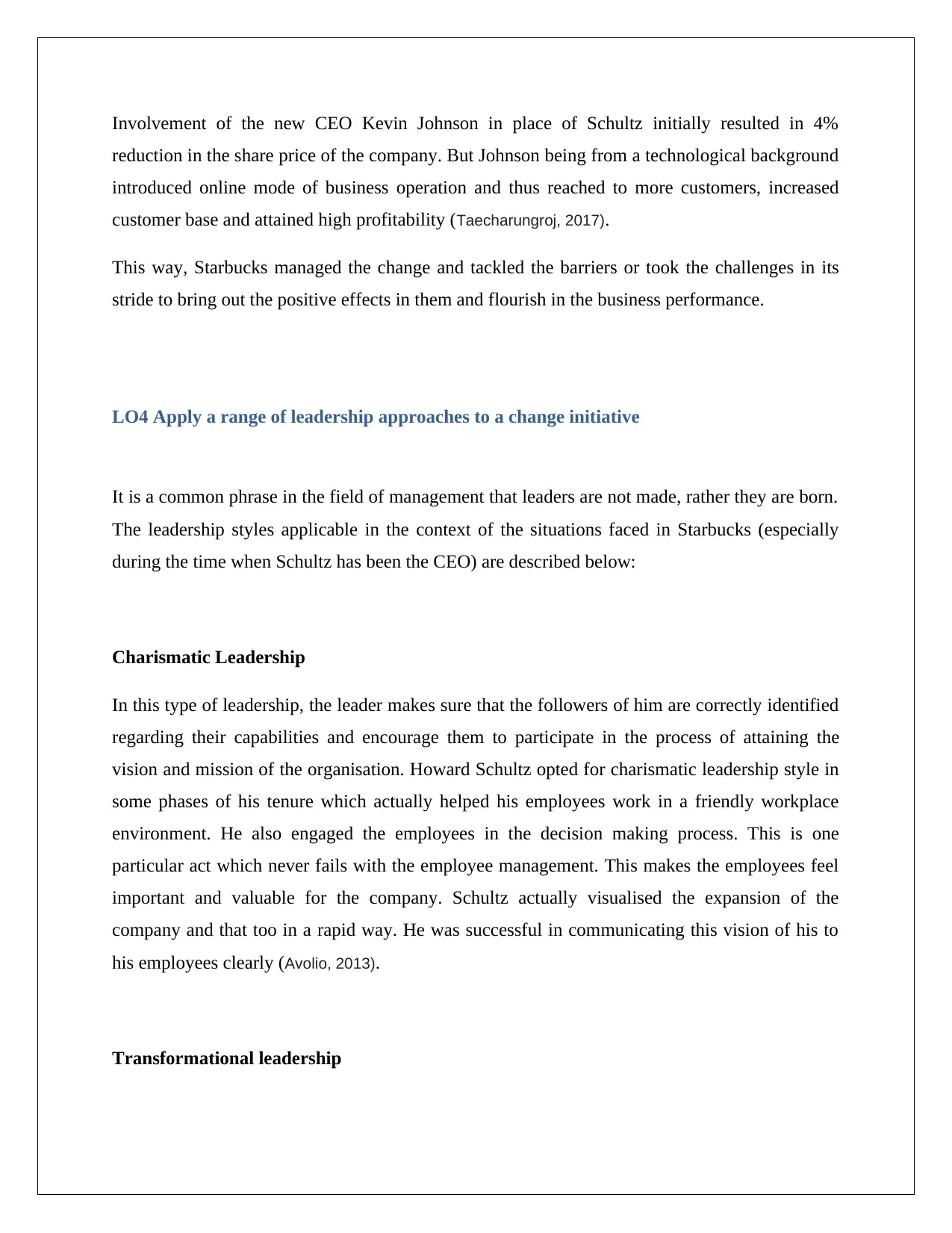
Involvement of the new CEO Kevin Johnson in place of Schultz initially resulted in 4%
reduction in the share price of the company. But Johnson being from a technological background
introduced online mode of business operation and thus reached to more customers, increased
customer base and attained high profitability (Taecharungroj, 2017).
This way, Starbucks managed the change and tackled the barriers or took the challenges in its
stride to bring out the positive effects in them and flourish in the business performance.
LO4 Apply a range of leadership approaches to a change initiative
It is a common phrase in the field of management that leaders are not made, rather they are born.
The leadership styles applicable in the context of the situations faced in Starbucks (especially
during the time when Schultz has been the CEO) are described below:
Charismatic Leadership
In this type of leadership, the leader makes sure that the followers of him are correctly identified
regarding their capabilities and encourage them to participate in the process of attaining the
vision and mission of the organisation. Howard Schultz opted for charismatic leadership style in
some phases of his tenure which actually helped his employees work in a friendly workplace
environment. He also engaged the employees in the decision making process. This is one
particular act which never fails with the employee management. This makes the employees feel
important and valuable for the company. Schultz actually visualised the expansion of the
company and that too in a rapid way. He was successful in communicating this vision of his to
his employees clearly (Avolio, 2013).
Transformational leadership
reduction in the share price of the company. But Johnson being from a technological background
introduced online mode of business operation and thus reached to more customers, increased
customer base and attained high profitability (Taecharungroj, 2017).
This way, Starbucks managed the change and tackled the barriers or took the challenges in its
stride to bring out the positive effects in them and flourish in the business performance.
LO4 Apply a range of leadership approaches to a change initiative
It is a common phrase in the field of management that leaders are not made, rather they are born.
The leadership styles applicable in the context of the situations faced in Starbucks (especially
during the time when Schultz has been the CEO) are described below:
Charismatic Leadership
In this type of leadership, the leader makes sure that the followers of him are correctly identified
regarding their capabilities and encourage them to participate in the process of attaining the
vision and mission of the organisation. Howard Schultz opted for charismatic leadership style in
some phases of his tenure which actually helped his employees work in a friendly workplace
environment. He also engaged the employees in the decision making process. This is one
particular act which never fails with the employee management. This makes the employees feel
important and valuable for the company. Schultz actually visualised the expansion of the
company and that too in a rapid way. He was successful in communicating this vision of his to
his employees clearly (Avolio, 2013).
Transformational leadership
Secure Best Marks with AI Grader
Need help grading? Try our AI Grader for instant feedback on your assignments.
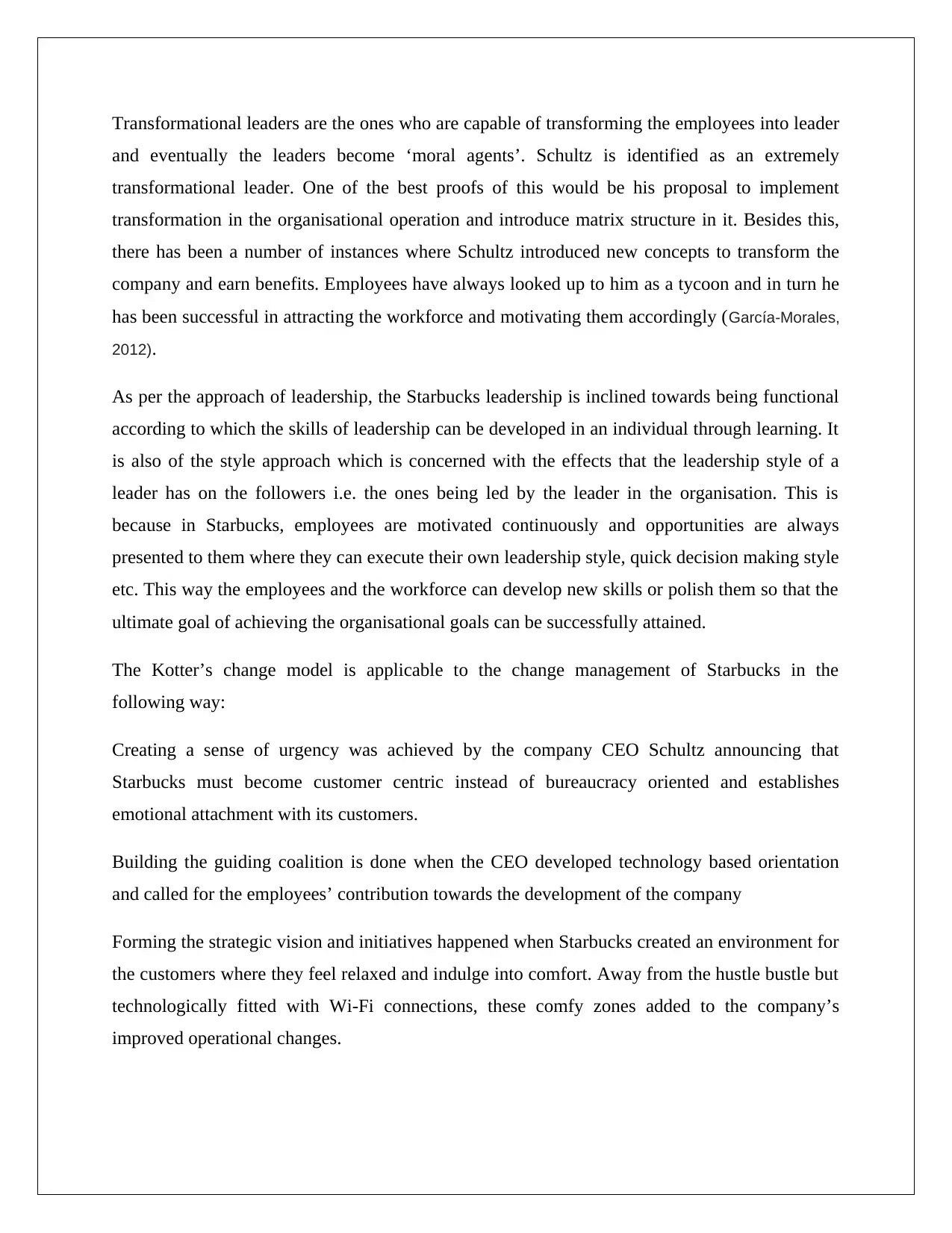
Transformational leaders are the ones who are capable of transforming the employees into leader
and eventually the leaders become ‘moral agents’. Schultz is identified as an extremely
transformational leader. One of the best proofs of this would be his proposal to implement
transformation in the organisational operation and introduce matrix structure in it. Besides this,
there has been a number of instances where Schultz introduced new concepts to transform the
company and earn benefits. Employees have always looked up to him as a tycoon and in turn he
has been successful in attracting the workforce and motivating them accordingly (García-Morales,
2012).
As per the approach of leadership, the Starbucks leadership is inclined towards being functional
according to which the skills of leadership can be developed in an individual through learning. It
is also of the style approach which is concerned with the effects that the leadership style of a
leader has on the followers i.e. the ones being led by the leader in the organisation. This is
because in Starbucks, employees are motivated continuously and opportunities are always
presented to them where they can execute their own leadership style, quick decision making style
etc. This way the employees and the workforce can develop new skills or polish them so that the
ultimate goal of achieving the organisational goals can be successfully attained.
The Kotter’s change model is applicable to the change management of Starbucks in the
following way:
Creating a sense of urgency was achieved by the company CEO Schultz announcing that
Starbucks must become customer centric instead of bureaucracy oriented and establishes
emotional attachment with its customers.
Building the guiding coalition is done when the CEO developed technology based orientation
and called for the employees’ contribution towards the development of the company
Forming the strategic vision and initiatives happened when Starbucks created an environment for
the customers where they feel relaxed and indulge into comfort. Away from the hustle bustle but
technologically fitted with Wi-Fi connections, these comfy zones added to the company’s
improved operational changes.
and eventually the leaders become ‘moral agents’. Schultz is identified as an extremely
transformational leader. One of the best proofs of this would be his proposal to implement
transformation in the organisational operation and introduce matrix structure in it. Besides this,
there has been a number of instances where Schultz introduced new concepts to transform the
company and earn benefits. Employees have always looked up to him as a tycoon and in turn he
has been successful in attracting the workforce and motivating them accordingly (García-Morales,
2012).
As per the approach of leadership, the Starbucks leadership is inclined towards being functional
according to which the skills of leadership can be developed in an individual through learning. It
is also of the style approach which is concerned with the effects that the leadership style of a
leader has on the followers i.e. the ones being led by the leader in the organisation. This is
because in Starbucks, employees are motivated continuously and opportunities are always
presented to them where they can execute their own leadership style, quick decision making style
etc. This way the employees and the workforce can develop new skills or polish them so that the
ultimate goal of achieving the organisational goals can be successfully attained.
The Kotter’s change model is applicable to the change management of Starbucks in the
following way:
Creating a sense of urgency was achieved by the company CEO Schultz announcing that
Starbucks must become customer centric instead of bureaucracy oriented and establishes
emotional attachment with its customers.
Building the guiding coalition is done when the CEO developed technology based orientation
and called for the employees’ contribution towards the development of the company
Forming the strategic vision and initiatives happened when Starbucks created an environment for
the customers where they feel relaxed and indulge into comfort. Away from the hustle bustle but
technologically fitted with Wi-Fi connections, these comfy zones added to the company’s
improved operational changes.
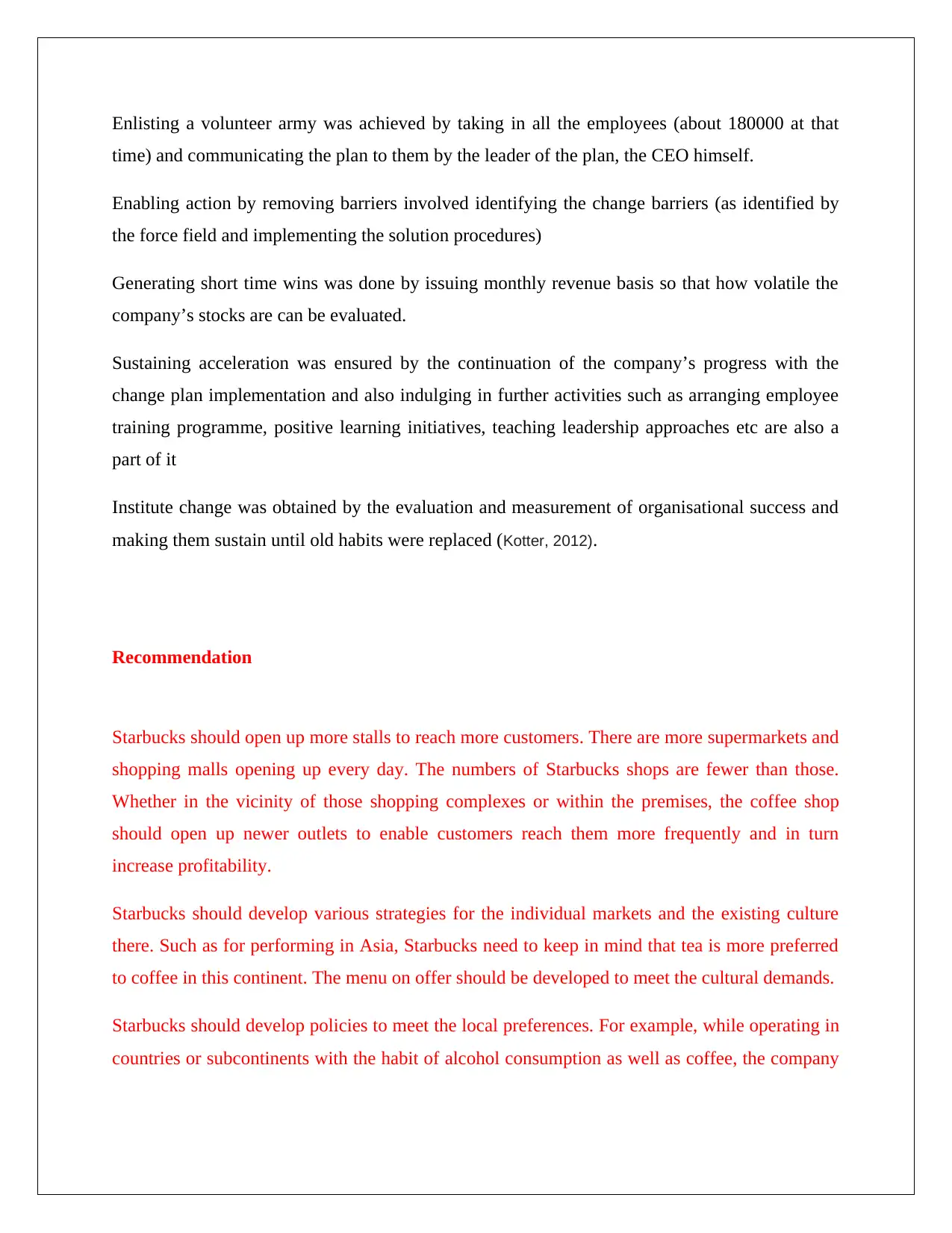
Enlisting a volunteer army was achieved by taking in all the employees (about 180000 at that
time) and communicating the plan to them by the leader of the plan, the CEO himself.
Enabling action by removing barriers involved identifying the change barriers (as identified by
the force field and implementing the solution procedures)
Generating short time wins was done by issuing monthly revenue basis so that how volatile the
company’s stocks are can be evaluated.
Sustaining acceleration was ensured by the continuation of the company’s progress with the
change plan implementation and also indulging in further activities such as arranging employee
training programme, positive learning initiatives, teaching leadership approaches etc are also a
part of it
Institute change was obtained by the evaluation and measurement of organisational success and
making them sustain until old habits were replaced (Kotter, 2012).
Recommendation
Starbucks should open up more stalls to reach more customers. There are more supermarkets and
shopping malls opening up every day. The numbers of Starbucks shops are fewer than those.
Whether in the vicinity of those shopping complexes or within the premises, the coffee shop
should open up newer outlets to enable customers reach them more frequently and in turn
increase profitability.
Starbucks should develop various strategies for the individual markets and the existing culture
there. Such as for performing in Asia, Starbucks need to keep in mind that tea is more preferred
to coffee in this continent. The menu on offer should be developed to meet the cultural demands.
Starbucks should develop policies to meet the local preferences. For example, while operating in
countries or subcontinents with the habit of alcohol consumption as well as coffee, the company
time) and communicating the plan to them by the leader of the plan, the CEO himself.
Enabling action by removing barriers involved identifying the change barriers (as identified by
the force field and implementing the solution procedures)
Generating short time wins was done by issuing monthly revenue basis so that how volatile the
company’s stocks are can be evaluated.
Sustaining acceleration was ensured by the continuation of the company’s progress with the
change plan implementation and also indulging in further activities such as arranging employee
training programme, positive learning initiatives, teaching leadership approaches etc are also a
part of it
Institute change was obtained by the evaluation and measurement of organisational success and
making them sustain until old habits were replaced (Kotter, 2012).
Recommendation
Starbucks should open up more stalls to reach more customers. There are more supermarkets and
shopping malls opening up every day. The numbers of Starbucks shops are fewer than those.
Whether in the vicinity of those shopping complexes or within the premises, the coffee shop
should open up newer outlets to enable customers reach them more frequently and in turn
increase profitability.
Starbucks should develop various strategies for the individual markets and the existing culture
there. Such as for performing in Asia, Starbucks need to keep in mind that tea is more preferred
to coffee in this continent. The menu on offer should be developed to meet the cultural demands.
Starbucks should develop policies to meet the local preferences. For example, while operating in
countries or subcontinents with the habit of alcohol consumption as well as coffee, the company
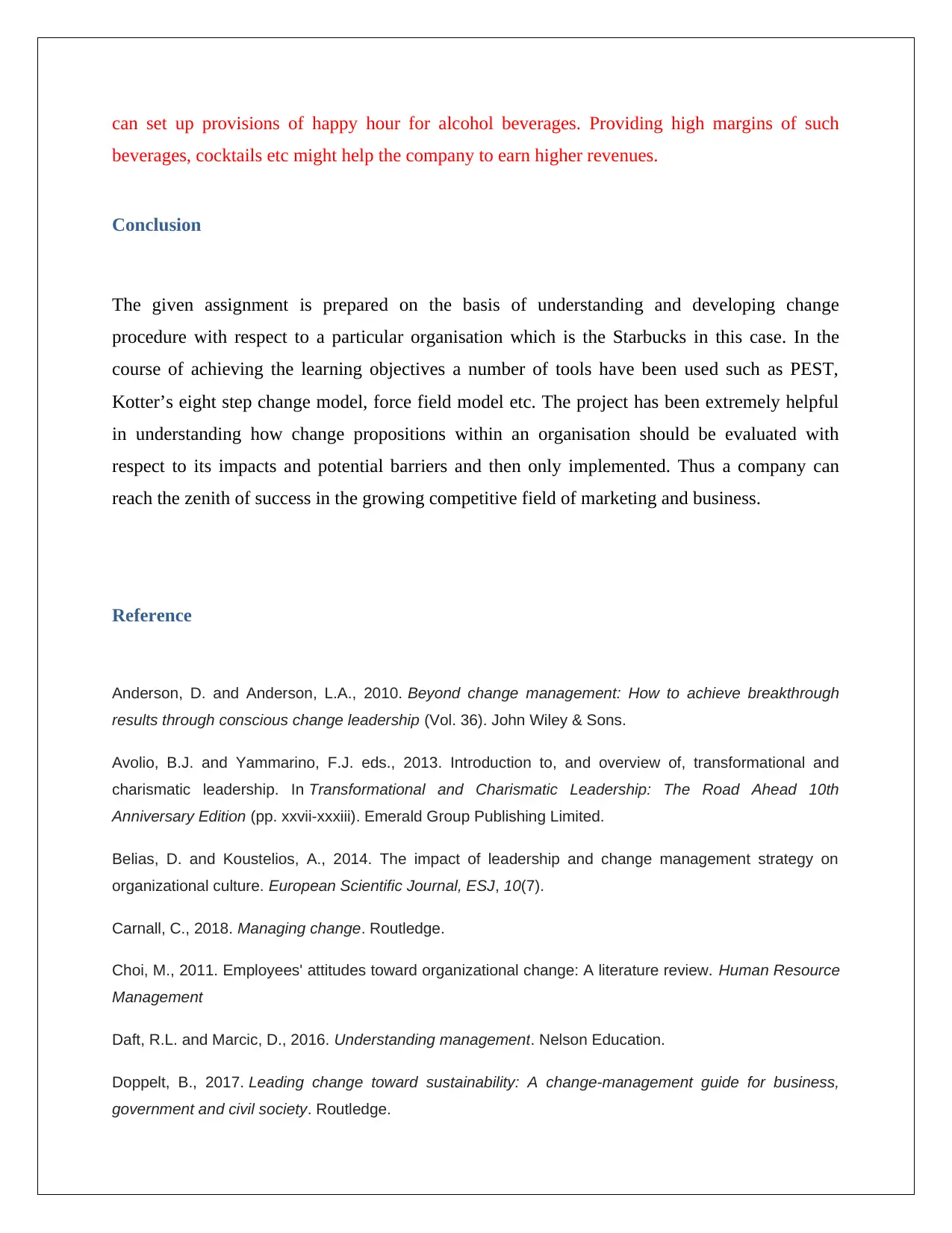
can set up provisions of happy hour for alcohol beverages. Providing high margins of such
beverages, cocktails etc might help the company to earn higher revenues.
Conclusion
The given assignment is prepared on the basis of understanding and developing change
procedure with respect to a particular organisation which is the Starbucks in this case. In the
course of achieving the learning objectives a number of tools have been used such as PEST,
Kotter’s eight step change model, force field model etc. The project has been extremely helpful
in understanding how change propositions within an organisation should be evaluated with
respect to its impacts and potential barriers and then only implemented. Thus a company can
reach the zenith of success in the growing competitive field of marketing and business.
Reference
Anderson, D. and Anderson, L.A., 2010. Beyond change management: How to achieve breakthrough
results through conscious change leadership (Vol. 36). John Wiley & Sons.
Avolio, B.J. and Yammarino, F.J. eds., 2013. Introduction to, and overview of, transformational and
charismatic leadership. In Transformational and Charismatic Leadership: The Road Ahead 10th
Anniversary Edition (pp. xxvii-xxxiii). Emerald Group Publishing Limited.
Belias, D. and Koustelios, A., 2014. The impact of leadership and change management strategy on
organizational culture. European Scientific Journal, ESJ, 10(7).
Carnall, C., 2018. Managing change. Routledge.
Choi, M., 2011. Employees' attitudes toward organizational change: A literature review. Human Resource
Management
Daft, R.L. and Marcic, D., 2016. Understanding management. Nelson Education.
Doppelt, B., 2017. Leading change toward sustainability: A change-management guide for business,
government and civil society. Routledge.
beverages, cocktails etc might help the company to earn higher revenues.
Conclusion
The given assignment is prepared on the basis of understanding and developing change
procedure with respect to a particular organisation which is the Starbucks in this case. In the
course of achieving the learning objectives a number of tools have been used such as PEST,
Kotter’s eight step change model, force field model etc. The project has been extremely helpful
in understanding how change propositions within an organisation should be evaluated with
respect to its impacts and potential barriers and then only implemented. Thus a company can
reach the zenith of success in the growing competitive field of marketing and business.
Reference
Anderson, D. and Anderson, L.A., 2010. Beyond change management: How to achieve breakthrough
results through conscious change leadership (Vol. 36). John Wiley & Sons.
Avolio, B.J. and Yammarino, F.J. eds., 2013. Introduction to, and overview of, transformational and
charismatic leadership. In Transformational and Charismatic Leadership: The Road Ahead 10th
Anniversary Edition (pp. xxvii-xxxiii). Emerald Group Publishing Limited.
Belias, D. and Koustelios, A., 2014. The impact of leadership and change management strategy on
organizational culture. European Scientific Journal, ESJ, 10(7).
Carnall, C., 2018. Managing change. Routledge.
Choi, M., 2011. Employees' attitudes toward organizational change: A literature review. Human Resource
Management
Daft, R.L. and Marcic, D., 2016. Understanding management. Nelson Education.
Doppelt, B., 2017. Leading change toward sustainability: A change-management guide for business,
government and civil society. Routledge.
Paraphrase This Document
Need a fresh take? Get an instant paraphrase of this document with our AI Paraphraser
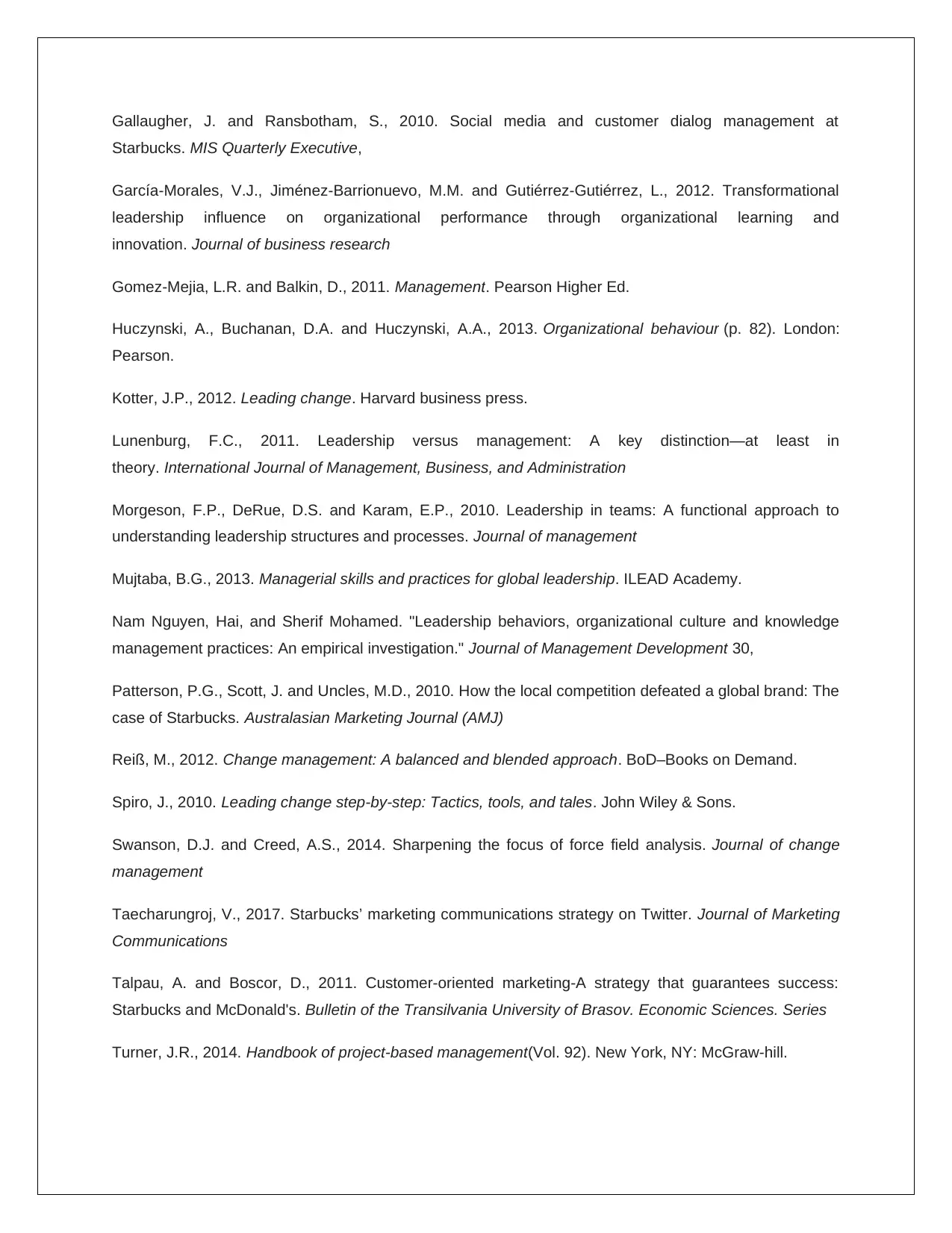
Gallaugher, J. and Ransbotham, S., 2010. Social media and customer dialog management at
Starbucks. MIS Quarterly Executive,
García-Morales, V.J., Jiménez-Barrionuevo, M.M. and Gutiérrez-Gutiérrez, L., 2012. Transformational
leadership influence on organizational performance through organizational learning and
innovation. Journal of business research
Gomez-Mejia, L.R. and Balkin, D., 2011. Management. Pearson Higher Ed.
Huczynski, A., Buchanan, D.A. and Huczynski, A.A., 2013. Organizational behaviour (p. 82). London:
Pearson.
Kotter, J.P., 2012. Leading change. Harvard business press.
Lunenburg, F.C., 2011. Leadership versus management: A key distinction—at least in
theory. International Journal of Management, Business, and Administration
Morgeson, F.P., DeRue, D.S. and Karam, E.P., 2010. Leadership in teams: A functional approach to
understanding leadership structures and processes. Journal of management
Mujtaba, B.G., 2013. Managerial skills and practices for global leadership. ILEAD Academy.
Nam Nguyen, Hai, and Sherif Mohamed. "Leadership behaviors, organizational culture and knowledge
management practices: An empirical investigation." Journal of Management Development 30,
Patterson, P.G., Scott, J. and Uncles, M.D., 2010. How the local competition defeated a global brand: The
case of Starbucks. Australasian Marketing Journal (AMJ)
Reiß, M., 2012. Change management: A balanced and blended approach. BoD–Books on Demand.
Spiro, J., 2010. Leading change step-by-step: Tactics, tools, and tales. John Wiley & Sons.
Swanson, D.J. and Creed, A.S., 2014. Sharpening the focus of force field analysis. Journal of change
management
Taecharungroj, V., 2017. Starbucks’ marketing communications strategy on Twitter. Journal of Marketing
Communications
Talpau, A. and Boscor, D., 2011. Customer-oriented marketing-A strategy that guarantees success:
Starbucks and McDonald's. Bulletin of the Transilvania University of Brasov. Economic Sciences. Series
Turner, J.R., 2014. Handbook of project-based management(Vol. 92). New York, NY: McGraw-hill.
Starbucks. MIS Quarterly Executive,
García-Morales, V.J., Jiménez-Barrionuevo, M.M. and Gutiérrez-Gutiérrez, L., 2012. Transformational
leadership influence on organizational performance through organizational learning and
innovation. Journal of business research
Gomez-Mejia, L.R. and Balkin, D., 2011. Management. Pearson Higher Ed.
Huczynski, A., Buchanan, D.A. and Huczynski, A.A., 2013. Organizational behaviour (p. 82). London:
Pearson.
Kotter, J.P., 2012. Leading change. Harvard business press.
Lunenburg, F.C., 2011. Leadership versus management: A key distinction—at least in
theory. International Journal of Management, Business, and Administration
Morgeson, F.P., DeRue, D.S. and Karam, E.P., 2010. Leadership in teams: A functional approach to
understanding leadership structures and processes. Journal of management
Mujtaba, B.G., 2013. Managerial skills and practices for global leadership. ILEAD Academy.
Nam Nguyen, Hai, and Sherif Mohamed. "Leadership behaviors, organizational culture and knowledge
management practices: An empirical investigation." Journal of Management Development 30,
Patterson, P.G., Scott, J. and Uncles, M.D., 2010. How the local competition defeated a global brand: The
case of Starbucks. Australasian Marketing Journal (AMJ)
Reiß, M., 2012. Change management: A balanced and blended approach. BoD–Books on Demand.
Spiro, J., 2010. Leading change step-by-step: Tactics, tools, and tales. John Wiley & Sons.
Swanson, D.J. and Creed, A.S., 2014. Sharpening the focus of force field analysis. Journal of change
management
Taecharungroj, V., 2017. Starbucks’ marketing communications strategy on Twitter. Journal of Marketing
Communications
Talpau, A. and Boscor, D., 2011. Customer-oriented marketing-A strategy that guarantees success:
Starbucks and McDonald's. Bulletin of the Transilvania University of Brasov. Economic Sciences. Series
Turner, J.R., 2014. Handbook of project-based management(Vol. 92). New York, NY: McGraw-hill.
1 out of 20
Related Documents
Your All-in-One AI-Powered Toolkit for Academic Success.
+13062052269
info@desklib.com
Available 24*7 on WhatsApp / Email
![[object Object]](/_next/static/media/star-bottom.7253800d.svg)
Unlock your academic potential
© 2024 | Zucol Services PVT LTD | All rights reserved.


